new posts in all blogs
Viewing: Blog Posts Tagged with: Scott McCloud, Most Recent at Top [Help]
Results 1 - 25 of 26
How to use this Page
You are viewing the most recent posts tagged with the words: Scott McCloud in the JacketFlap blog reader. What is a tag? Think of a tag as a keyword or category label. Tags can both help you find posts on JacketFlap.com as well as provide an easy way for you to "remember" and classify posts for later recall. Try adding a tag yourself by clicking "Add a tag" below a post's header. Scroll down through the list of Recent Posts in the left column and click on a post title that sounds interesting. You can view all posts from a specific blog by clicking the Blog name in the right column, or you can click a 'More Posts from this Blog' link in any individual post.

By:
Heidi MacDonald,
on 7/20/2015
Blog:
PW -The Beat
(
Login to Add to MyJacketFlap)
JacketFlap tags:
Comics,
Conventions,
First Second,
Scott McCloud,
Convention,
Gene Yang,
Top News,
SDCC '15,
comic-con panels,
aron steinke,
asuf hanuka,
Add a tag
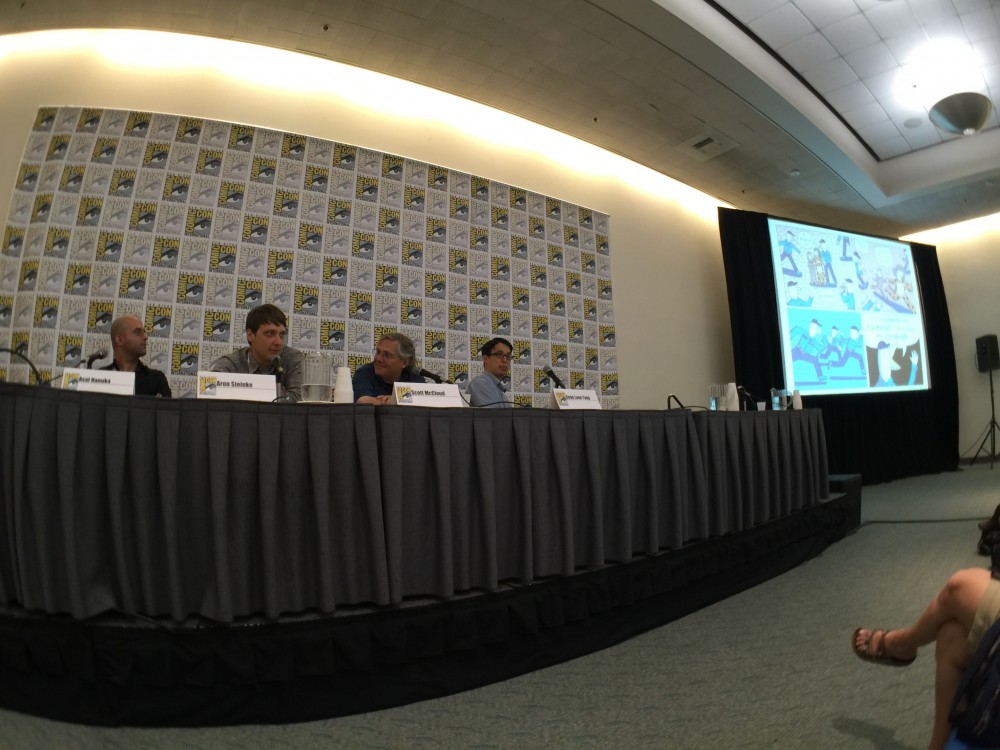
A great comic book let’s your brain relax and enjoy as you take in each page of the story. You’re not trying to figure out which panel to read next, or be taken out of the story unexpectedly. Instead the creator has made choices in storytelling that take you smoothly through the story and subconsciously informing your mind with all the metaphors, themes, and subtext required. First Second’s What’s in a Page panel aimed to give the audience some insight into those choices from four of their creators: Asuf Hanuka (The Divine) Aron Nels Steinke (The Zoo Box), Scott McCloud (The Sculptor), Gene Luen Yang (The Shadow Hero).
The panel limited each of the creators to just one page from their graphic novels to walk the audience through. Calista Brill of First Second moderated the panel and asked each of the authors for additional insight.
It was mentioned to Steinke that when constructing a page of comics for a western audience it’s expected they will read from left to right and from top to bottom, as is true with text. Being a teacher was that something he thought about when putting together comics for kids and using ways of reinforcing easy reading?
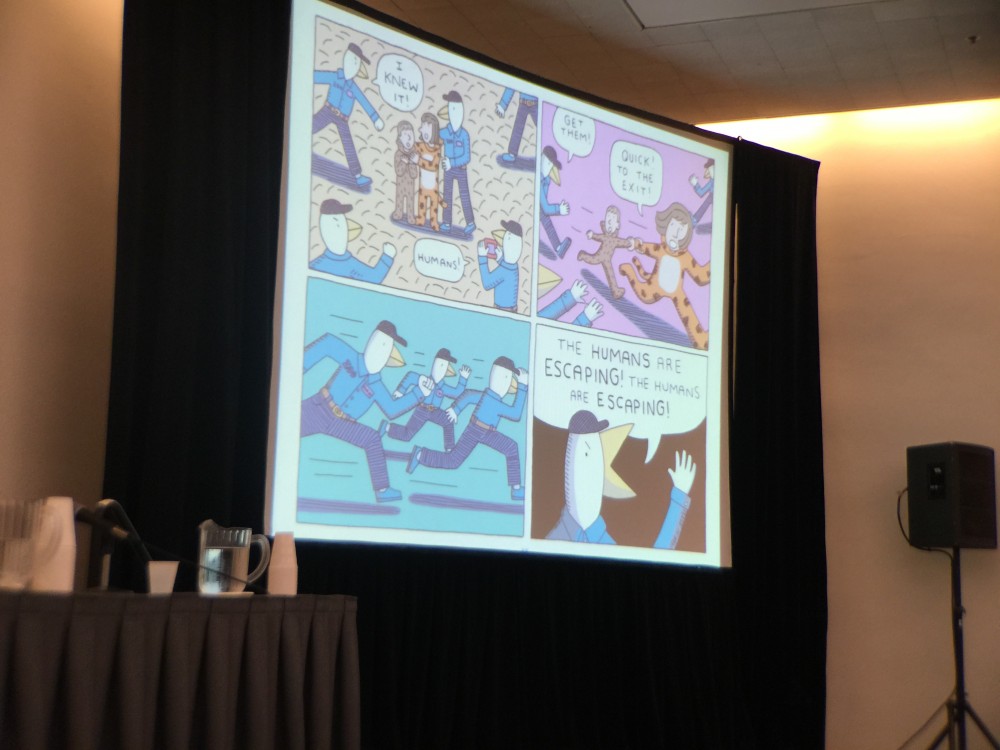
Aron Nel Steinke – Panel from The Zoo Box
Aron Nels Steinke: “I definitely think about that. Most of my students I’ve worked from 1st-3rd grade. It’s very rare when a student doesn’t understand how to go left to right. But there are times where they do but they kind of get it after a while. If you make it so there really only is one way, then they’ll understand that really this is the next sequence.”
Hanuka had chosen a very vivid page and it was noted how the lead character is handsome, and nice and symmetrical. You’re not afraid to get really grotesque. What drove that choice?
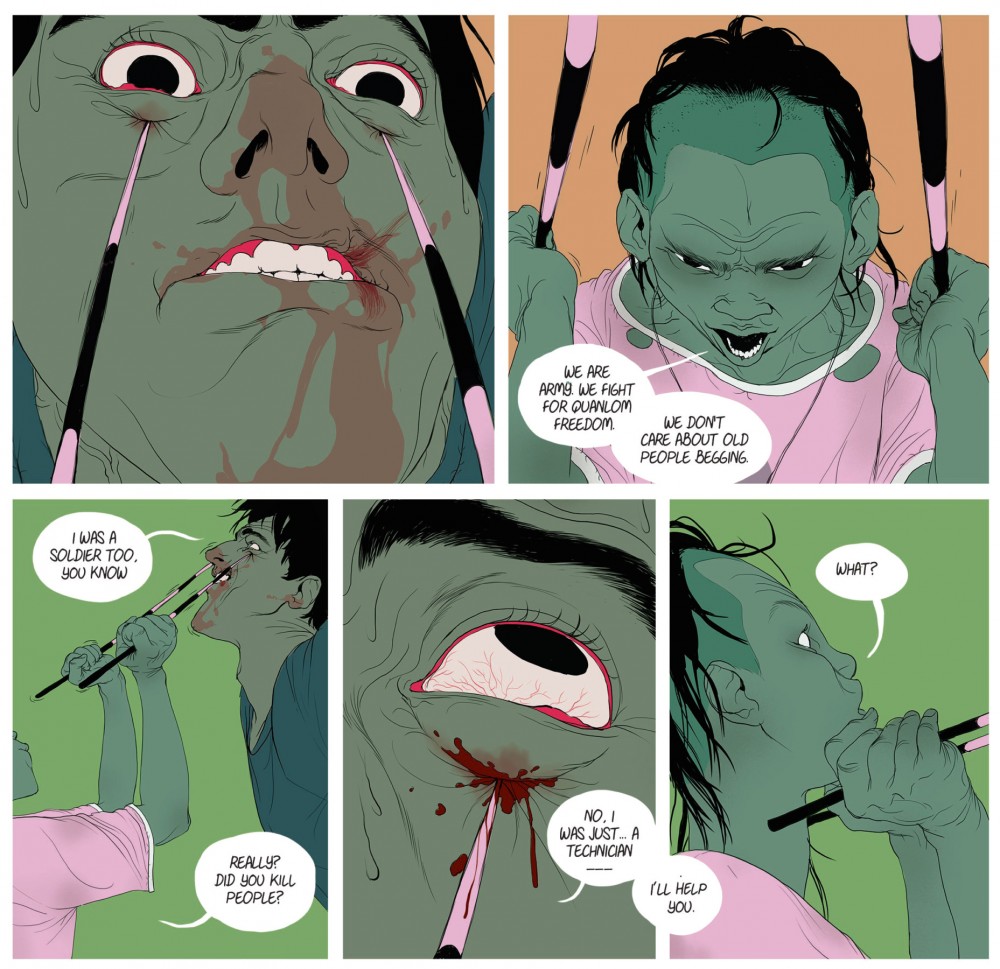
Asuf Hanuka – Sample Panel from The Divine
Asuf Hanuka: “It’s really hard to do something beautiful without showing something ugly. I guess it’s just a way of creating contrast. We did have red lines for stuff we didn’t want to do.”
The notion of a red line, or line the creators wouldn’t cross, was a bit humorous considering the amount of violence in in the book where people have brains and spines ripped from their bodies. So it was surprising to hear there were lines the creators wouldn’t cross. The crowd laughed at McCloud’s quip regarding how that violence was portrayed.
Scott McCloud: “But tastefully”
For McCloud’s page he kind of cheated having chosen a two-page spread. This spread in particular from The Sculptor was chosen to show how he was experimenting with auditory experience of the main character.
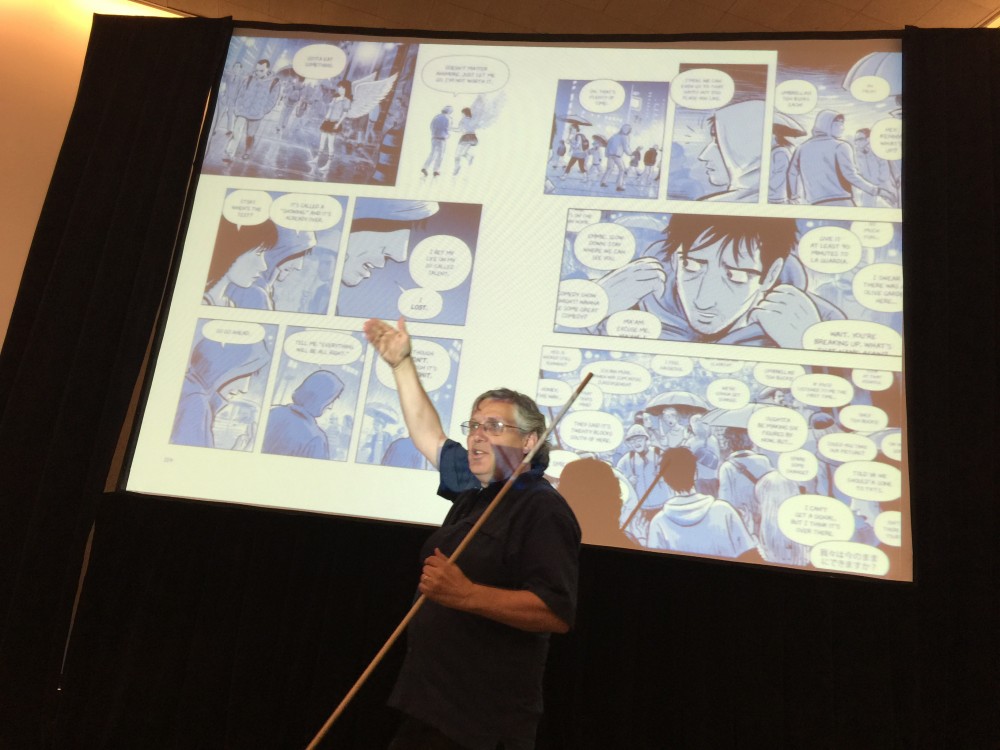
Scott McCloud – Presenting Panel from The Sculptor
Scott McCloud: “The reason I like this spread is because it was an opportunity when I’m doing everything visually to see if I could do something auditory. Where it’s all about somebody trying to find a real person in a crowd. And so I just have voices, and voices, and voices and this is what Times Square is. I wanted you to have a sense of what it is to be like inside of his head.”
Gene began with two pages from separate the separate books of his two volume series Boxers & Saints. He joked that he immediately regretted the choice as they’re probably not comics in the McCloud definition. He picked them so he could talk about the duality of the two scenes based on the themes in the graphic novels
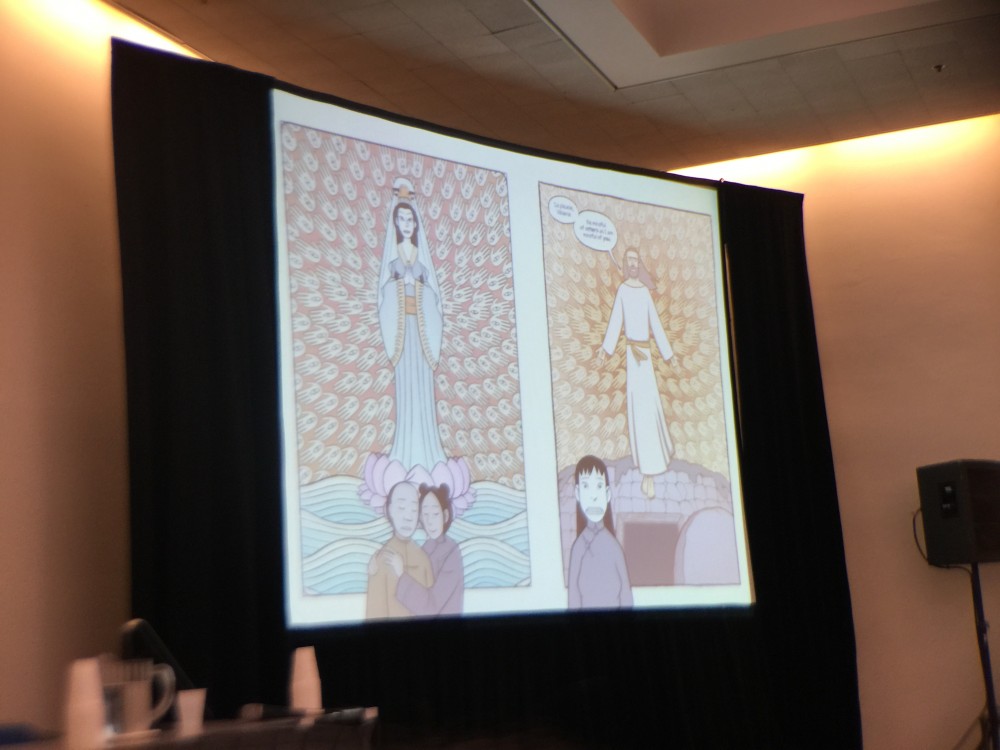
Gene Yang – Panel from Boxers and Saints
Gene Yang: “The reason I did two volumes [Boxers and Saints] was because I couldn’t decide who I sided with. I couldn’t decide who the protagonists are. So the protagonists in one book are the antagonists in the other. So that’s what these two panels are all about. I just wanted to visually represent that resonance between the two cultures.”
After having gone through each creators selected pages the floor was opened up to questions. The first one allowed for some interesting insight from the creators. It was asked “What informs your choices when choosing the panel layout and which panels or pages will be contained vs a full bleed?”
Yang’s response came from a narrative point of reference—
Gene Yang: “I actually had a debate in my head about whether or not to make these [the two pages selected] bleed. I think visually it would’ve been more striking. But narratively each of the larger images represents something that is happening in the heads of the characters that are at the bottom. So by containing it in something kind of a panel it’s sort of a visual representation of that.”
while Steinke’s was born from humorous practicality.
Aron Nels Steinkie: “First my answer involves the laziness on my part. When you do a bleed you’re drawing art work that won’t actually get printed. It’ll get printed and it’ll get chopped, by the chopper. Because it bleeds and goes off to the edge of the page. One of my favorite cartoonists is the cartoonist Joe Socko and he does a lot of bleeds. And I think about all the inches of artwork that we don’t get to see because it’s been chopped from the paper cutter. That’s one reason and another is I try to use it for emotional impact. So whenever I do go to the effort to make that extra effort it’s got to be for a reason.”
Hanuka’s response was more rooted in the experience of comics and it’s physical medium—
Asuf Hanuka: “I think it’s a question of taste. For me I prefer to never go to a bleed because I believe the magic of the comics language is that you’re seeing a universe through a window. And so you need the window. And if it goes all the way to the end of the page, then you’ve seen the end of the page—and it’s paper and something about the illusion disappears. But I think that in some cases you can do it. But for me it has to be really—like—if the Earth explodes. Yeah, let’s go to the edge. Save it for the important moments.”
and as to be expected McCloud’s response blended metaphor, theory, and art.
Scott McCloud: “I do use bleeds a lot. I think the most important thing for me about bleeds is that they are well named. It’s a really good name—bleed. If you think of any panel as a kind of container it’s like an organ that contains fluids. And it contains time. If you have three panels in a row—boom, boom, boom—then it has this nice staccato rhythm. It’s telling you “Here’s an instant. Here’s an instant. Here’s an instant.” Or maybe a span of time. But it’s a container. It contains your sense of the duration of the panel. That this thing is—holding, time, in— and so it has a nice feeling of containment. When you lose that edge something happens in our perception”…
“What happens when you have a panel bleed is it really almost literally bleeds time. As it goes to the edge of the page there’s a sense the duration just flows outward. If you have a bleed at the beginning of a spread for example, that instant will seem to become a lingering moment. It has an echo. It has a reverberation. And it tends to bleed throughout that spread. You can sort of feel it sinking in. That’s why they’re so good for establishing shots. You have a nice bleeding establishing shot and then that sense of place in that one little box becomes a sense of place for the whole spread. If the whole scene takes place in that place, then you have that sense of place throughout. It escapes time. Time—bleeds—out. It’s well named.”
Another audience question brought up how audiences are also reading digitally now, and how that’s increasing with, “I’m curious about what kind of impact digital is having as far as laying out the page?” At this McCloud had to leave so he could make it to the other side of the convention center to participate in another panel. It was another humorous moment for the audience considering McCloud’s many thoughts on the topic, hence his own jab at himself leaving on the digital topic.
Scott McCloud: “And also, I’ll never stop talking.”
The rest of the panel seemed to still be working that question out for themselves as they work, realizing it’s two worlds still very much sharing space from a creative endeavor.
Asuf Hanuka: “Personally I don’t read any digital comics. I only read on paper. But everything I do and create is digital. It’s on computer. Even the penciling—it’s called penciling, but it’s really a Cintiq pen on a screen. The thing I like about digital is that I know the color will look exactly like it looked on the screen. And the printing quality will be always [sic] perfect for everyone and that’s amazing. But I don’t have any specific changes that I will make in the layout design, or the storytelling, or the drawing style because it’s going to be on the screen and not on paper. For me it’s the same thing.”
Aron Nels Steinke: “My published work I’m generally thinking about turning a page in a book. That’s how I enjoy reading comics the most.” …
“I would like to see digital versions of my books or any other books done panel by panel. I really like the way my friend Zac Soto—who has a group called Study Group—a lot of times when they put their work online it’s an infinite canvas going vertically. Because that’s how you’re scrolling if it’s online.”
At this the moderator mentioned “Design for devices and print should be designed for that medium. But usually not both.”
Gene Yang: “When I am writing my own comics, and making my own comics, I almost always am just thinking about the print version. Mostly because like Aron—I love that page turn. I can’t imagine doing without it. It seems to me that most comics, even if they’re presented digitally, are still formatted for print. There’s still the concept of the page which is purely a print thing.”
In finishing his thought Yang helped the moderator sign off the panel on another laugh.
Gene Yang: I know Scott—it’s too bad he left!
Moderator: If he had stayed this would be a whole other panel.
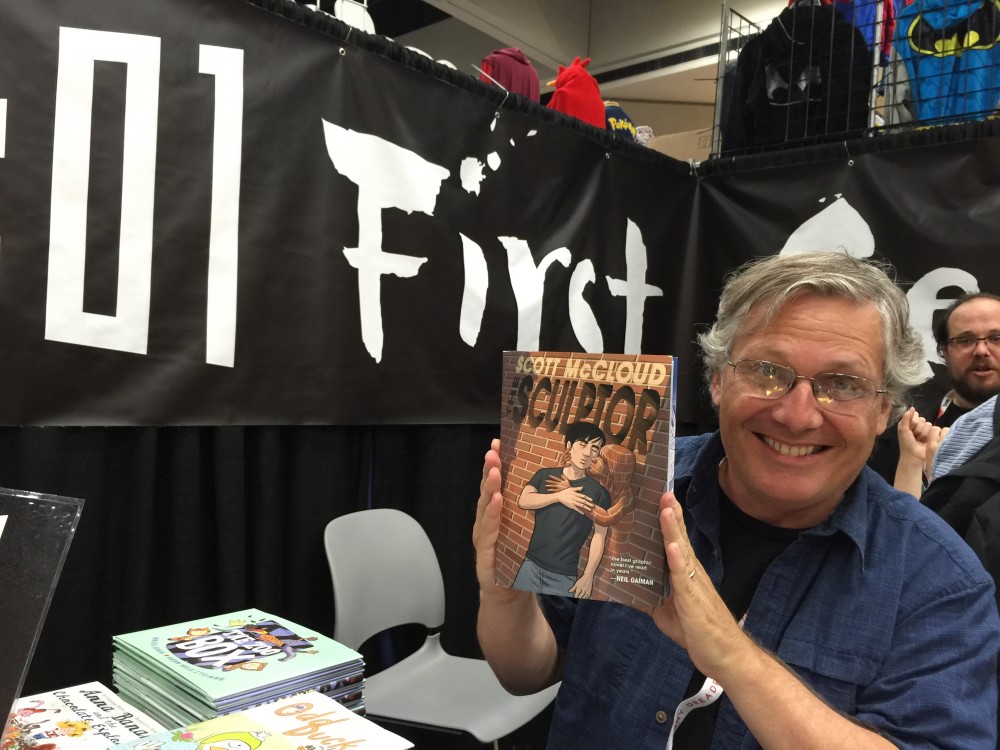
Scott McCloud – SDCC ’15
At San Diego Comic-Con I had a chance to sit with Scott McCloud where we talked about industry changes and how storytelling has changed as our world has gotten smaller, creative anxieties and mindful awareness, the art of visual communication, and how that all influenced his latest book The Sculptor.
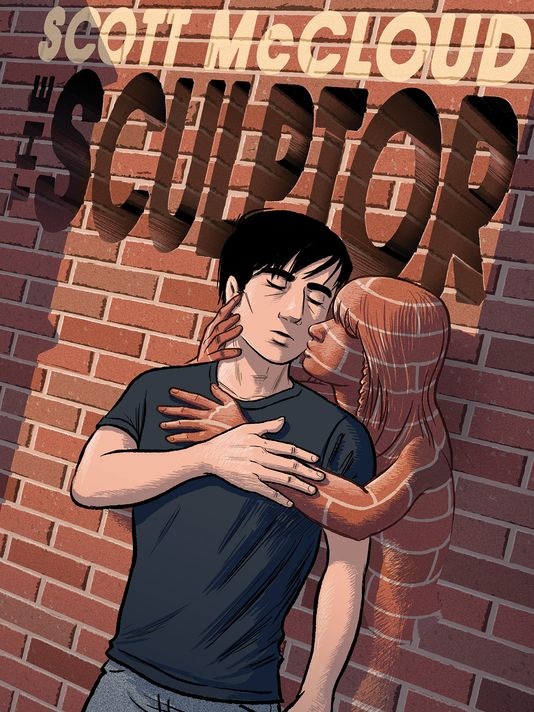
The Sculptor – Published by First Second
Victor Van Scoit: To start anecdotally, the last time I got to speak with you I attended your workshop. It was in L.A. and I was in the workshop that had what I believed was a normal class size. We had 12 people.
Scott McCloud: Oh yeah. That was the little one. Yeah, yeah I remember that—
VV: It was really interesting because you said how that was oddly a small class size. Normally you’re used to around 30 people. Also we only had one or two women.
SM: Yeah usually it’s pretty balanced these days.
VV: That’s one of the things I wanted to mention. Around ten years ago I remember seeing you speak in Texas and you’d mentioned you were really looking forward to this convergence. What you expected to happen with Western storytelling and this manga influence that these young boys and girls were getting that would eventually grow up to be creators.
SM: Especially the girls. Those girls, sitting cross legged in Barnes & Noble reading Fruits Basket and all. Yeah I had this prediction.
VV: And we’re seeing it! I mean I think we are.
SM: Yeah! We’re going to pass 50 percent pretty soon. It’s going to be a majority female industry.
VV: I think it’s been real great just to see the convergence of also the storytelling. You’re working with First Second and one of the books I think of is Last Man over from France which has this great mixture. What’s it been like for you? You’re not the type of person to say I told you so, but it’s got to make you feel good to see that you’re reading the vibe correctly.
SM: [laughs] In this one case I’ll definitely do an “I told you so” just because I sort of laid an informal bet about that majority female industry. I marked it as 2024 so I’ll definitely crow a little if I was right about that one.
VV:I think you’re on point.
SM: The readership is already approaching 50/50 but we want to get the industry and the output of the industry also lined up as well. We want to have just as many female characters for example. I’ll definitely do a little Snoopy dance if I get that one right. That’s a nice long term prediction to make.
But manga was definitely an important part of that. And that manga boom was a fascinating Big Bang for that phenomenon. You know at a certain point about 15-20 years ago it occurred to me that of these three big nations of comics—I think of them as The North American tradition, the Japanese tradition, and the Franco-Belgian tradition which spread out over Asia, Europe and North America—each one had its own way of looking at comics. And the important thing with manga was making you feel like you were part of the story. And the important thing with the European tradition was world building. I thought it would be real cool to put those two together, and I was trying to do that with the latest graphic novel. It’s very strongly in the manga tradition but also has a really heavy world building feeling to it too. Like New York is almost a character in the book. It’s a very international book that way.
What’s funny is that if you look at Japan in the 90s and the 2000s you start to see the European influence coming over. You start to see manga artists influenced by European artists. And sure enough who do we think of when we think of that internationalist theme? We think of [Hayao] Miyazaki and we think of [Katsuhiro] Otomo, right? And what both of them have in common compared to a lot of their manga contemporaries is that they were world builders. They were incredibly obsessive world builders. They took the time to draw every last little little part of their world.
VV: I’m glad you mentioned how you approached that in The Sculptor. That’s one of the things I was interested in. We started talking about how young kids are going to be influenced by this convergence and that’s subconsciously driven. But how did you approach it more consciously and take steps to bring those two storytelling worlds together?
SM: Well it was easy for me because I got a head start. Back in the early 80s I was working at DC Comics. This is 1982. I got a job at DC Comics in Manhattan right out of college. In fact I got the job three weeks before I left college. DC Comics was in Rockefeller Center and they were three blocks away from Books Kinokuniya, the biggest Japanese bookstore in all of Manhattan, and the whole second floor was comics.
VV: I love that bookstore because of that.
SM: And they didn’t shrink wrap the fuckers.
VV: [laughs]
SM: They did not shrink wrap them. So I could go on my lunch hour. I’d get either a hot dog, or a knish on the street, or I’d bring a sandwich. But the point is lunch lasted four or five minutes for me, and then boom I was out the door and I would spend the rest of that hour stand reading. This is something Japanese businessmen did, is they would just stand on their lunch hour and read their comics. Just stand. Read. Stand and read right in the shop and that’s what I did. I bought a lot of them but I read many, many more. That’s when I discovered all these techniques. It took me a while to sort of list all these techniques that they were doing in Japan but not here. There was a point, a kind of eureka moment where I saw that they were all essentially the same idea. Which was making you feel that you were in the story instead of watching it. Making you feel like a participant instead of an observer. Make you feel like instead of watching a character move across the scene, you were the one doing the moving. You were the one experiencing the emotion. You were the one absorbing all of the sensations in your environment. That’s the Japanese way. There may be no coincidence that Japanese comics were 30 times as popular as in North America, twice as popular as in Europe. That was all a long time ago and I incorporated it into Zot! and I incorporated those ideas into Understanding Comics so in a lot of ways it’s been with me for so long that it came naturally. It was actually a very natural thing.
VV: I remember reading it in your comics but especially began to see it in some of the mainstream comics that thing that Japanese manga and animation has always been real good at is taking the moment to pause. Slowing the clock down. Having empty frames in there. I noticed from a pacing perspective in The Sculptor you’re definitely doing that. There were also portions that I would just zoom through.
SM: Oh yeah. People read that book very fast, often in one sitting, despite the 500 pages it can clock in at two or three hours.
VV: It seems daunting at first, but I killed it all at once. Is that a common occurrence that you’re hearing?
SM: Extremely common. It’s almost a cliche now that when I talk to somebody about The Sculptor chances are one-in-two that I’ll find out that they read it in one sitting.
VV: Do you think maybe it’s because it’s playing a movie in their head?
SM: It’s definitely cinematic. It definitely has that narrative momentum, but it also has that sense of participation. So if I’ve done my job right you should feel like you’re there because of those Japanese techniques. And you should feel like the world is a rich, sensory environment because of that European approach. That can create a kind of traction, a kind of friction, where you just want to know what happens on the next page. You know? All you have to do—it’s very simple like a binary thing—all I have to do is on any given page make you want to read the next page. If I can just do that every page—I’m done. You’re going to keep going
VV: I like how in the book there’s a few panels that feed literally into that. The panel transitions into the next page. Like you’re purposely doing that.
SM: Yeah like my hand—I’m grabbing your hand and turning that thing. Time is so important in this book. We’ve got a character who has 200 days to live, and that idea of slowing the clock becomes front and center. Towards the end of the story without giving too much away, there’s a moment where the ticking of the clock becomes like this really loud feeling and you just want to reach up and just stop the hands of the clock. I’m talking about a sequence which is a series of full page spreads one after another, after another, where barely a fraction of a second is going by but you have these huge images. What I’m essentially trying to do even as you’re paging through the thing and going very fast you’re also, I hope, experiencing that sensation of the whole world slowing down and the desire to stop time from proceeding. Because comics is such a temporal medium. Because it’s so much about the passage of time in a spatial medium. That to me is very comics. Even though I tried to create a story where you wouldn’t be thinking about all the formal stuff. It’s still there. It still has its voice.
VV: Those full page spreads you’re talking about I imagine you hope people stop and take in everything that’s going on
SM: I know they’ll flip by them fast. [laughs]
VV: But if they do stop and allow for that decompression of time… it makes me think of a study that came out recently that one of the best way to remove the anxiety of life and time slipping by is to have a moment of awe for the day. Whether it’s seeing a great movie, beautiful artwork, or a beautiful sunset apparently it shows that that moment of awe can let you decompress time a little bit and make it seem a little less imposing.
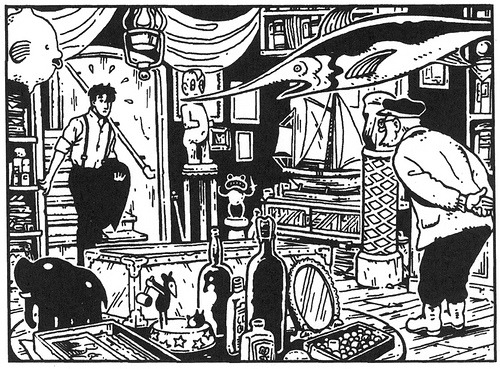
Jar of Fools – Example of Narrative Density
SM: This is what I call narrative density. There are tiny little panels that I’ve stared at for a really long time because there was so much to see. There was so much information in them. Not detail, not just lots and lots of lines and lots and lots of objects. But objects and details that had presence, that had meaning, that had some kind of narrative density. There’s a little panel in a book called Jar of Fools by Jason Lutes that came out back in ‘94. I stared for a really long time at this panel because all it was was the room of the protagonist. The protagonist comes home to his room and there were so many details in that room that told you about the protagonist – an empty birdcage, a bare lightbulb, bars on the windows, lots of liquor bottles over a bare sink. There was so much that was telling you about him that it slowed you down. But that whole thing was no bigger, the actual panel, was barely bigger than your thumb. But it had narrative density. What you’re just describing, that idea of what slows down the clock for us—also things like mindful experiences during the day. I’m a great believer in mindful eating. You put your feet flat on the floor, if you can if you’re not too short like my wife, and you let your whole body relax and enjoy the sensation of the food and think about the sensation of the food. I like that slow process to kinda happen with comics too.
VV: I think that awareness is key. Even touching back to The Sculptor that’s kind of what David is learning.
SM: Yeah. That’s exactly what he’s learning.
VV: I remember thinking that I really liked, I don’t think is spoiling anything, but when he gets the power to create whatever he wants his first result isn’t that great.
SM: No no. [laughs] It’s a failure!
VV: Yes you can do something amazing, but ultimately if you’re not creating art from a good place it still might be less than.
SM: Right, exactly. Getting all of your external obstacles taken care of is not necessarily going to solve your internal obstacles. And yeah it doesn’t solve his problems at all. Because he doesn’t have whatever it takes inside him to make this work is still not there. Now he comes up against the ultimate obstacle himself. That’s a much, much bigger wall to climb than he thought it was going to be.
VV: Yes there’s a couple themes in here. Whether it’s identity, anxiety of creative expression, but a really great one is that even some of my friends who are creators they can be amazing with what they’re doing but there’s always that little devil inside that makes them question it.
SM: Everybody has that. Absolutely.
VV: The story, there’s Meg, she kind of helps him get past some of those obstacles but because of that clock going away from him he’s, “Agh I finally found that thing!”
SM: Yeah as the clock gets faster and faster for him in terms of his work, she is helping to slow the clock. She’s helping to slow him down. Gradually he finds ways to slow himself down. It’s like you’re trying to slow your heart beat. You’re trying to place yourself almost in a state of suspended animation. One thing that we have to remember about this story is that this is a story about a guy who only has so many days to live and has to make the most of them. That’s not a fantasy.
VV: [laughs]
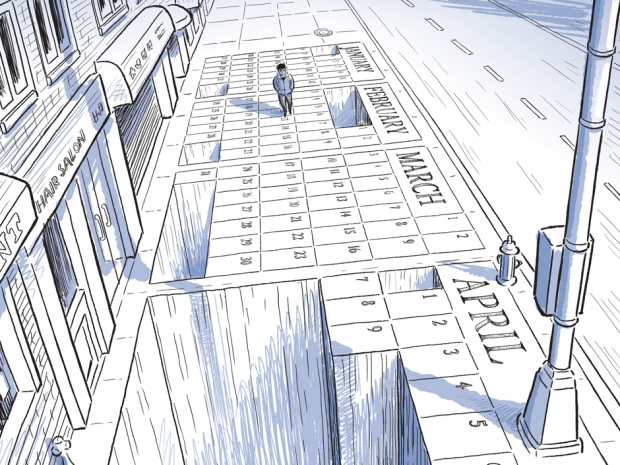
The Sculptor – “The actual fact of life for every single one of us—all of us have a limited number of days.”
SM: That just happens to be the truth. The actual fact of life for every single one of us—all of us have a limited number of days. It doesn’t matter whether we know the number or not.
VV: I can imagine how that must’ve been frustrating for you because I know how you like to take time with your work. Not because you’re slow—
SM: I’m pretty slow
VV: —but because you put a lot of thought and process.
SM: I’m also slow. [laughs]
VV: Well I’ve seen examples of all your Photoshop layers and thumbnails and the way you plan it all out. For each page as you drew that wasn’t finished you kept imagining that clock yourself.
SM: Oh yeah. Oh man. It was there. It was originally going to be a three year project. It turned into a five year project, and that was 11 hours a day, seven days a week
VV: The book [The Sculptor] has been out roughly now six months and you know the story you intended to tell and get across, but have there been any angles or surprises you’re hearing about that people are getting from the book that you didn’t expect?
SM: I wouldn’t say it’s a surprise because it was part of my basic intention but it has been actually gratifying to find out how many people read it straight through. It’s that common that it’s kind of funny now how I hear it almost every single time. [laughs]
So many people just plowed through that thing. Hearing about people who it kind of broke or who were grateful for something that sounds extremely painful and awful. People will describe it—Wil Wheaton talked about it, I forgot what he said exactly, but it was essentially like he had been beaten to within an inch of his life by a brutal gang. He didn’t use those words exactly. It sounded like a wounding experience. But it’s like people are ready for that. It was interesting people seem to be ready or even grateful for any work of art, any kind of story that can physically assault them. That makes them actually feel. That actually raises bruises. I guess that doesn’t happen very often.
VV: Or even confront certain things that they’re not prepared for, much like David has to deal with himself as an obstacle sometimes the right story comes along and asks the questions you really don’t want to answer.
SM: Well I’ve heard from a few people who found it disturbing how much of themselves they saw in David. I have a lot of affection for David. I don’t see it as such a hell to be him. But a lot of people found that the fact that they had a connection with that character they found disturbing. They found it a real challenge to themselves.
VV: This might sound strange, but you mention affection for David, which many others likely have. Yet in reality to start out with he’s not exactly the most likable.
SM: Oh he’s kind of a dick to be sure. [laughs] In fact he was even more of a dick in the earlier drafts. I just couldn’t go all the way towards dick. But there’s been stories of dicks before that people have related to. Even MacBeth if done right has some kind of bridge to our common shared sense of humanity. And that was the challenge for me, for David not to be the other in the eyes of the reader even as he was this prickly, arrogant, self-obsessed, narcissistic sort of a character. There had to be something about him that you could build a bridge to and I hope that I was able to do that for most readers to find some kind of emotional bridge. I also do have great admiration for his perseverance, for his honesty, for his willingness to adhere to these ridiculous promises he makes to himself. You know it’s a kind of virtue. At least he keeps his promises. [laughs] Again I do have that affection. But it’s interesting, it’s not quite as simple as that there’s a level of obnoxiousness that readers will not go beyond. You can be horrible. You can be Hannibal Lecter for God’s sake. You can be Walter White in Breaking Bad and people will still find some kind of a connection to [the character]. It’s an interesting formula. There’s a bit of alchemy to the creation of a character that you can identify with even as you find them detestable.
VV: I guess when it comes to yourself people love to identify you as the educational, almost a mentor in the comics world. You’ve finished The Sculptor. You’re now spreading the word and marketing it, but do people have to worry about you leaving that behind—that educational side of you? It’s seems like such a part of you I would almost find it impossible to stop.
SM: [laughs] Well there’s no danger in my completely stopping pontificating. My next book in nonfiction and it’s going to be about visual communication. Not about comics specifically, although comics is in the mix, but I want to talk about the way that we communicate with and learn from images
VV: Visual communication sounds perfect because maybe once again you’re on that rising tide or cusp moment of identifying into words what people feel. That “Oh! That’s why I consume these things that way” or “That’s why I enjoy this thing this way”.
SM: Right which was a phenomenon with Understanding Comics. A lot of people felt that was that little voice in their head finally giving word to something that they already were experiencing—that they already understood on some level. That is something I’d like to bring to the subject in visual communication.
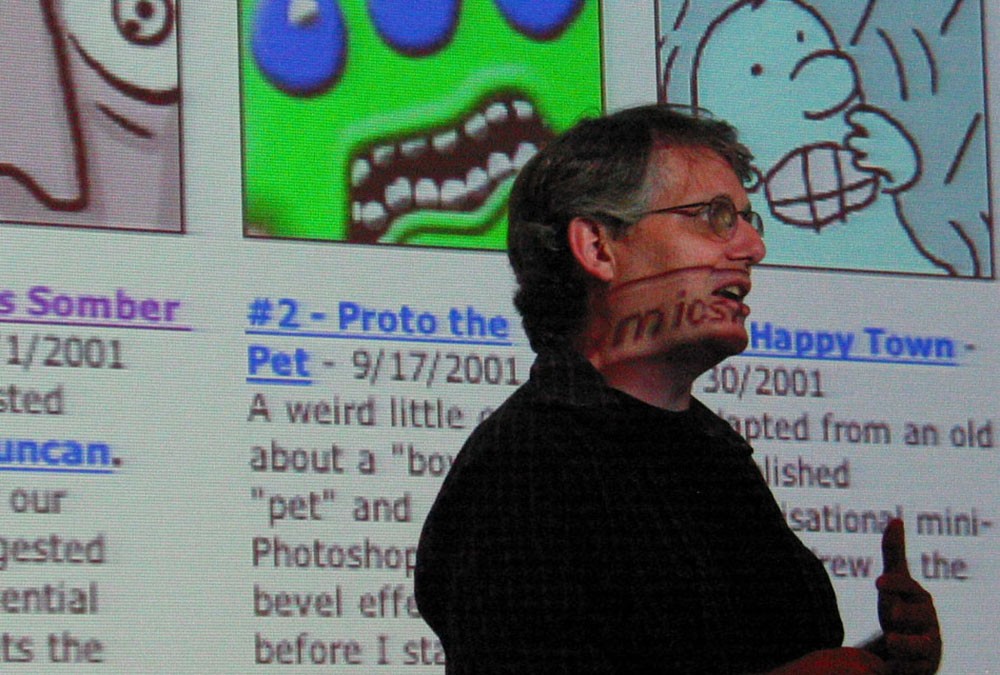
Scott McCloud – Education and Presentation
VV: I hope so. One of the things I really loved from your workshop, reading your books, and hearing you speak is that idea of cognitive load. That conjoined with the potential for educational side of comics or any graphic medium or storytelling. People worried in the early days with graphic novels whether it was good for kids to learn from because sometimes there’s not as many words, but there’s sometimes so much more to deal with [compared to a book]. You mentioned that with Jar of Fools in that you’re taxing the brain in multiple ways even if there’s not as many words.
SM: Oh absolutely.
VV: Is that one of the focuses?
SM: That’s part of it, yes. I’m interested in everything from picture books to presentation—the philosophies that people have of presenting in PowerPoint and Keynote—and of course like data visualization, information graphics, nonfiction comics, animation. All of the different ways that we set out to communicate and then all of the ways that we communicate almost without meaning to.
VV: So this book will extend past the comic books format?
SM: Well I have to go—I have to stay true to my religion that comics can communicate anything. It’ll still be comics but it’s not going to be quite like Understanding Comics or Making Comics. It won’t stay within the panel. It’s going to be probably more graphically bold. But there will still be the narrator. I’ll still have the guy in the check jacket, getting ever fatter with slightly whiter hair, will be there explaining things.
VV: Hopefully it will touch people the same way Understanding Comics or Making Comics did to create, but from a presentation standpoint alone it seems like it could be the perfect thing to hand someone if they need to do a TED-like talk.
SM: That’s part of it actually. My philosophy of presentation is that something where I’ve actually been doing it [long enough] now that I’ve developed some pretty strong ideas. That’ll be part of it.
VV: If nobody has seen you speak before I highly recommend to do so. For my take it’s a way of getting a lot of information and sometimes not even realizing how much you process. Because you don’t use bulleted lists, few words, and the graphics once again bring in that cognitive load of taking in multiple items at once. Without even taking notes, afterwards being surprised at how much is retained.
SM: Thank you. I think that those dynamics that you just listed are in fact present in a lot of other disciplines. And that’s one of the reasons why it was exciting to me to tackle this as a book. I realized that, “Oh you know what?” people in presentations are knocking on some of the same doors that the people in data visualizations are, people in information graphics are, even the people who study facial expressions and body language a lot of them are looking at the same core principles and trying to reinvent the wheel. I want to see if I can find out what those principles are, the ones that run across all of those disciplines simultaneously. Are there a few fundamental core truths about the way we learn with pictures.
VV: I think it’ll be great. Outside of The Sculptor and your other books where can people potentially get to see some more of you? Are you doing any tours?
SM: I’m still doing speaking gigs with a busy fall coming up. You can find that just at scottmcloud.com in the sidebar. Though I have to update that sidebar because it’s clogged with the 100 straight days of touring we did in the U.S. and seven european countries. I always do lectures around the country and you’ll always find them at scottmccloud.com right there on the front page.
VV: Oh! One last question before it leaves me. One of the things that I appreciate about [your approach] and others like Gene [Luen Yang] is that you’re creators but you come at it from a—I think Gene mentioned it last year at a panel when people talk about the conflicted artist. He comes at it from almost a left brain scenario of not understanding that conflict. Just draw. It’s just like engineering. Just get it done. So it’s really nice to see both your approaches to be able to analyze.
SM: Well Gene and I—we’re a particular tribe. Gene and I are both I believe are the sons of engineers. I think his dad was an engineer too like mine. I could be wrong about that part. We’ll fact check that. (VV: Gene’s dad was indeed an electrical engineer)
VV: I just want people to know that you don’t have to be “Mr. Emotional” to be a creator.
SM: You don’t. You don’t. But I think for those who have a kind of emotional altitude over things—like Gene and I who like to analyze and that have a pretty sunny disposition—we do create certain types of work. We’re part of the ecosystem. What we can bring to the medium is one thing, and then what other people who maybe have that darker disposition they bring a different perspective to the work that’s equally vital, equally important. A lot of very conflicted, very dark, very sort of inarticulate artists have created some of the most lasting works. It’s like any ecosystem. You want all those tribes working simultaneously. We’re sort of in the teachers, the research and development wing, and the tinkerers—those guys—we serve a particular role in this ecosystem.
VV: I know it made me feel better because when I took your workshop I no longer have any artistic ability whatsoever by comparison to some of these professionals. It was reassuring that I could take your class having none of that, but could still take a lot from a learning perspective or if I did want to create how best to communicate ideas with an artist. So I think you’re doing great work on that side of the house.
SM: That’s wonderful to hear. Thank you Victor.
VV: Thanks for your time. We really appreciate it.
SM: My pleasure. This was fun.
Scott McCloud is a comic book creator best known for his work Zot!, theoretical and educational books Understanding Comics Reinventing Comics, and Making Comics, and most recently The Sculptor published by First Second Books and available now..
Title: The Sculptor
Author: Scott McCloud
Publisher: First Second
Publication Date: February 3, 2015
ISBN-13: 978-1596435735
496 pp.
ARC provided by publisher via NetGalley
Comic book authority Scott McCloud wrote and illustrated the graphic novel The Sculptor, his first work of fiction in over 20 years. The fact that it's already in development for a film should give you a clue that it's a

MoCCA Fest has just announced its programming. With the festival of indie itself is set for April 11-12th at a new venue, the Center 520, programming will be held a short walk away at the High Line Hotel at 180 Tenth Avenue and 20th Street. Curated by Bill Kartalopoulos, the schedule includes several tie-ins to the current Alt-Weekly Comic shows up at the SOI, as well as three ticketed events, with Scott McCloud Aline Kominsky-Crumb and Raina Telgemeier. Tickets are free with MoCCA admission but you need to sign up at the SOI website now to reserve a space.
While the line-up of panelists is impressive, including the three above superstars and also Rebecca Mock, Annie Goetzinger, Kim Deitch, Julia Wertz and many more; Kartalopoulos has lined up an equally erudite slate of panel moderators, drawn from NYC’s greater cultural world: MoMA curator Laura Hoptman; avant-garde poet and Ubuweb founder Kenneth Goldsmith; curator and Saul Steinberg Foundation managing director Patterson Sims; Hyperallergic senior editor Jillian Steinhauer; New York Times art director Alexandra Zsigmond, and more.
All in all, state of the comics art and as usual the problem is finding time to buy all the new comics while still attending all the great programming.
Here’s the complete line-up:
SATURDAY PROGRAMMING
12:30 pm / The Matthews Room of the High Line Hotel
Scott McCloud Q+A *
Scott McCloud is widely acclaimed as North American comics’ most influential theorist. His 1993 analysis-in-comics-form Understanding Comics is a staple of university classrooms, and has found application in other forms including interactive and interface design. Reinventing Comics addressed the form and economy of digital comics and issues of diversity within the comics field, and Making Comics offered a guidebook to constructing effective narrative work. He was the Guest Editor for The Best American Comics 2014. His most recent work is The Sculptor, a fictional graphic novel. Moderated by Bill Kartalopoulos.
* Reservations required. RSVP by signing up for a ticket through the Society’s website.
12:30 pm / The Rusack Room of the High Line Hotel
Work in Progress
This is the ultimate sneak preview: Four artists will discuss graphic novels they are currently working on, showing pages yet-to-be-published from books yet-to-be-announced, and revealing material that lays bare their working methods. This session will offer a rare glimpse of work fresh from the drawing table, and will bring us directly into the processes of artists Kim Deitch, Sarah Glidden, Dash Shaw, and Julia Wertz, all of whom are currently working on new and surprising books. Moderated by Richard Gehr, author of I Only Read It for the Cartoons.
2:00 pm / The Matthews Room of the High Line Hotel
Aline Kominsky-Crumb Q+A *
Aline Kominsky-Crumb is one of the most significant artists to emerge from the underground comix movement of the 1960s and ’70s. Kominsky-Crumb fled an upbringing in Long Island, finishing a BFA at the University of Arizona and proceeding to San Francisco. She discovered underground comix and began drawing pioneering expressionistic, autobiographical work. After publishing with the Wimmen’s Comix collective, Kominksy-Crumb and Diane Noomin co-founded Twisted Sisters, which later became a pair of influential anthology books. She was the editor of Weirdo and has frequently collaborated with her husband, Robert Crumb. She will discuss her work in this special session with MoMA curator Laura Hoptman.
* Reservations required. RSVP by signing up for a ticket through the Society’s website.
2:00 pm / The Rusack Room of the High Line Hotel
Building an Image
In this unique and insightful panel, a group of striking image-makers will peel back the layers behind the process of creating memorable images. Sam Bosma, Kali Ciesemier, andRebecca Mock will discuss the artistic labor behind their work, revealing both the technique and the thought process behind their images. Nathan Fox, a striking image-maker himself and the chair of SVA’s MFA in Visual Narrative program, will lead the discussion and also share his own working process.
3:30 pm / The Matthews Room of the High Line Hotel
Raina Telgemeier Q+A *
Raina Telgemeier has distinguished herself as the leading American artist producing graphic novels for younger readers. Her autobiographical graphic novel Smile has spent more than two years on the New York Times Graphic Books bestseller list, and her follow-up, Drama, has won the Stonewall Book Award among other distinctions. Most recently she has published a sequel to Smile titled Sisters, and Scholastic will soon republish in full color her earlier series ofBaby-Sitters Club comics adaptations. Telgemeier will discuss her work with School Library Journal reviews editor Luann Toth.
* Reservations required. RSVP by signing up for a ticket through the Society’s website.
3:30 pm / The Rusack Room of the High Line Hotel
Plagiarism as Practice
The boundaries between inspiration and infringement are increasingly vague and increasingly contested in the post-internet era, even as we approach the centennial of Duchamp’s seminal masterpiece of appropriation, Fountain. Avant-garde poet and ubuweb founder Kenneth Goldsmith teaches Uncreative Writing at the University of Pennsylvania. He will discuss plagiarism as practice with comics artists Ilan Manouach, whose Katz re-presented Maus with all of the heads redrawn and sparked a legal action in France; Blaise Larmee, who has tested the limits of appropriation and impersonation online; and R. Sikoryak, whose Masterpiece Comics appropriate canonical literature and classic comics.
SUNDAY PROGRAMMING
12:30 pm / The Matthews Room of the High Line Hotel
Alt-Weekly Comics
Beginning with the Village Voice in the 1950s and peaking with a wave of publications in the 1980s and 1990s, alternative weekly newspapers spoke with an independent voice to local communities, and comics were a distinct part of those papers’ visual identities. Coinciding with the Alt-Weekly Comics exhibit currently on view at the Society of Illustrators, this panel will consider the phenomenon of alt-weekly comics with art director and editor Bob Newman (The Seattle Sun, The Rocket and The Village Voice) and cartoonists Ben Katchor, Michael Kupperman, and Mark Newgarden. Moderated by Bill Kartalopoulos.
12:30 pm / The Rusack Room of the High Line Hotel
Biography: The Lives of Artists
Memoir, non-fiction and biography have emerged as significant categories in comics. Comics about artists represent a special challenge: the cartoonist must represent the work of an artist through his or her own visual approach, revealing points of disjunction and harmony.Hyperallergic Senior Editor Jillian Steinhauer will discuss these issues with French comics legend Annie Goetzinger, whose Girl in Dior chronicles the first season of the storied fashion house; James Romberger and Marguerite Van Cook, whose 7 Miles a Second was both a biography of and a collaboration with David Wojnarowicz; and Dutch cartoonist Barbara Stok, whose Vincent makes Van Gogh approachable through a style completely unlike his own.
2:00 pm / The Matthews Room of the High Line Hotel
We Hire Cartoonists
Cartoonists have often pursued split-careers as illustrators or other kinds of graphic artists in order to build stable careers. Increasingly, art directors and editors are hiring cartoonists to bring the entire capacity for visual narrative to editorial projects, especially online where new technologies offer another set of emerging techniques and formats. A panel of editors and art directors including Tablet’s Wayne Hoffman, Autostraddle’s Ali Osworth, and New York Times Art Director Alexandra Zsigmond have all frequently worked with cartoonists in a variety of ways, online and in print. They will talk about what they do, the innovations they’ve pursued, and what they look for in the work they commission.
2:00 pm / The Rusack Room of the High Line Hotel
Saul Steinberg 101
Saul Steinberg (1914-1999) occupies a unique place in cultural history. A popular modernist, his work as a cartoonist, illustrator and fine artist appeared on magazine covers and gallery walls. His work frequently referred to the iconography and conventions of cartooning and continues to fascinate with its inventive expression of sophisticated concepts through abstracted imagery and pure line. Cartoonist Austin English, multidisciplinary artist Richard McGuire, New Yorker art editor Françoise Mouly, and Morgan Library curator Joel Smith will discuss the lesson they’ve learned from Steinberg’s work with The Saul Steinberg Foundation’s Managing Director Patterson Sims.
3:30 pm / The Matthews Room of the High Line Hotel
R. Sikoryak and Neil Numberman Present: CAROUSEL for KIDS!
Acclaimed cartoonist R. Sikoryak brings a special KIDS’ edition of CAROUSEL, his long-running series of live comics readings and other projected pictures, to the MoCCA stage, co-hosted by Neil Numberman (Do NOT Build a Frankenstein!). Featuring Jon Chad (Leo Geo),Sam Henderson (Nickelodeon Magazine’s Scene But Not Heard), Kevin McCloskey (We Dig Worms!), Mark Newgarden & Megan Montague Cash (Bow Wow’s Nightmare Neighbor,Joey Fly: Private Eye), Nadja Spiegelman & Sergio García Sánchez (Lost in NYC), Raina Telgemeier (Sisters), and more! Stories, gags, audience participation, and more, for kids of all ages.
3:30 pm / The Rusack Room of the High Line Hotel
Comics and Disability
The rise of disability studies has prompted a non-hierarchical reconsideration of disability. In parallel, the emergence of “outsider art” has enlarged aesthetic possibilities within art, but not without introducing new category problems. This panel will trace emerging points of engagement between these issues and comics. Ilan Manouach will discuss Shapereader, his innovative 57-plate graphic novel for the blind. Anne-Françoise Rouche is the director of La “S” Grand Atelier in Vielsalm, Belgium, an arts center for persons with mental disabilities that organizes collaborations with contemporary artists. Frémok artist DoubleBob, who has participated in these projects, will join the discussion. Moderated by Bill Kartalopoulos.
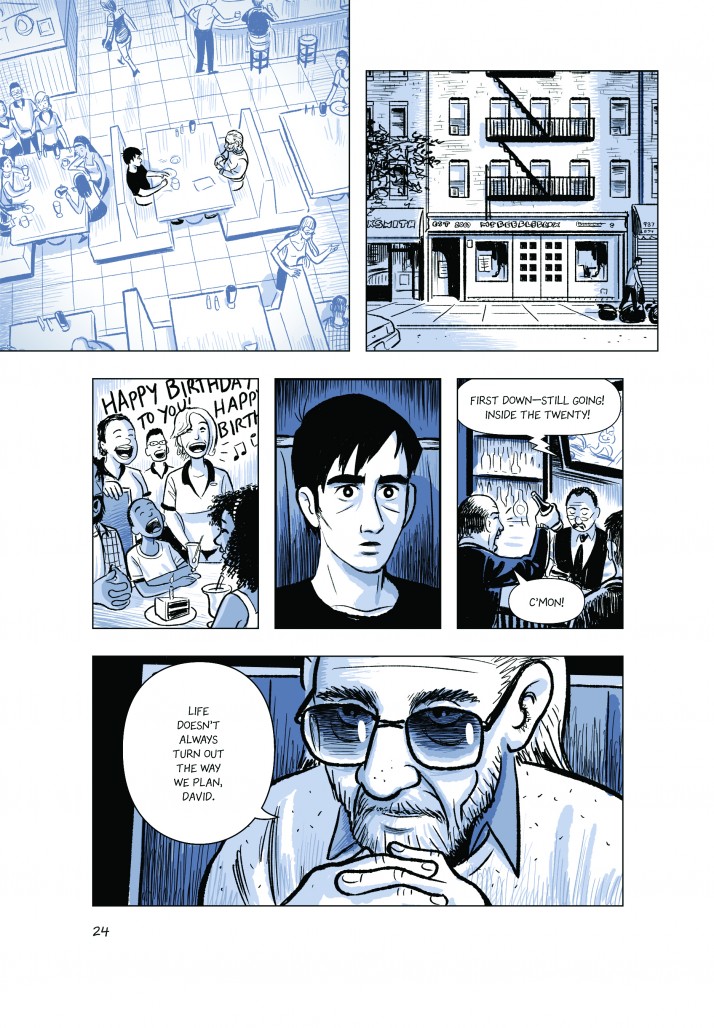 When it rains, it pours as it comes to news of comics getting gobbled up for adaptation. Following the just announced Dreadstar television series deal, THR is now reporting that Sony has picked up the film rights to Scott McCloud‘s acclaimed graphic novel The Sculptor.
When it rains, it pours as it comes to news of comics getting gobbled up for adaptation. Following the just announced Dreadstar television series deal, THR is now reporting that Sony has picked up the film rights to Scott McCloud‘s acclaimed graphic novel The Sculptor.
The film will be produced by Academy Award winner Scott Rudin (No Country for Old Men, The Grand Budapest Hotel) and Josh Bratman (Captain Phillips).
The Sculptor, McCloud first fictional comics work since 1998’s The New Adventures of Abraham Lincoln, has only been out via First Second for two weeks and has been incredibly well-received by the critical community. You can read Beat contributor Harper Harris‘ review here, as well as our interview with McCloud on the process of creating the nearly 500 page graphic novel.
 Here are some literary events to pencil in your calendar this week.
Here are some literary events to pencil in your calendar this week.
To get your event posted on our calendar, visit our Facebook Your Literary Event page. Please post your event at least one week prior to its date.
Three writers will appear at the Pen Parentis Literary Salon. Join in on Tuesday, February 10th at Andaz Wall Street from 7 p.m. to 9 p.m. (New York, NY)
Six authors will participate in the “Unconventional Teen Romance” panel. Check it out on Thursday, February 12th at Books of Wonder from 6 p.m. to 8 p.m. (New York, NY)
Scott McCloud will perform a reading of his newest graphic novel, The Sculptor, at Macalester College. Meet him on Saturday, February 15th at the John B. Davis Lecture Hall starting 4 p.m. (New York, NY)
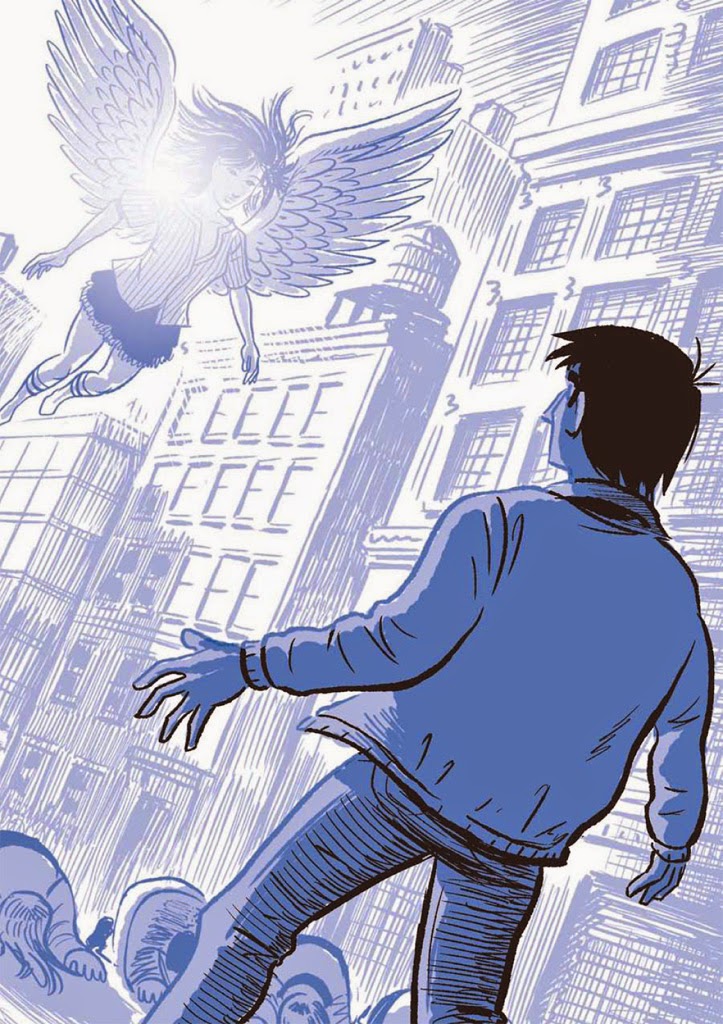
By Harper Harris
Although Scott McCloud has worked on fiction comics before, it’s been a while. He wrote and drew his fantastically unique superhero series Zot! in the mid-eighties, and since then the only major return was writing a few issues of Superman Adventures in 1996 and The New Adventures of Abraham Lincoln in 1998. What he’s most famous for is his work within comics theory, in the form of the seminal Understanding Comics, Reinventing Comics, and finally Making Comics. These are highly regarded works amongst the comics community; reading the first often marks the beginning of a true devotee to sequential storytelling, acting as a kind of benchmark in fandom. McCloud set a pretty high bar for himself with this series when he set out to return to comics fiction with his massive new graphic novel, The Sculptor, and luckily for him, it mostly holds up to the sort of scrutiny that he brought to the comics world with his analytic books.
The Sculptor revolves around the life of David Smith, a young artist who we find at his lowest: the acclaim surrounding his earlier work has faded away, he has no family left, and he’s spending his last few bucks on a cheap diner meal for his twenty sixth birthday. The inciting action of the book is a Faustian deal with death: David agrees that for the power to create great art, he will only live for 200 more days. Although his new found powers–the ability to sculpt any material with just his bare hands–grants him artistic ability, he still struggles to deal with the fickle art world and most importantly, the fact that he may have met the love of his life with just a few months to live.

The writing is quite strong. David, while not the most likeable guy in every circumstance, is relatable and familiar, especially if you’ve ever known a fine artist. He’s frustrating but inspiring, and his struggles, both existential and tangible, hit a lot of the right emotional beats. It’s a massive graphic novel at just under 500 pages, but for the majority of the book it is a page turner; I found myself not knowing where things were going, in a very exciting way. McCloud throws in many different conflicts, from a breakdown in communication with a loved one to the inability to make art that is both crowd-pleasing and truly great. Perhaps most noteworthy is his portrayal of depression, which comes across as refreshingly true-to-life, not using it as a plot device but rather making it a crucial part of character development.
The art, too, is perhaps McCloud’s best. There’s an excellent sense of pacing that subtly draws you into the perspective of David, with things moving along quickly with smaller gutter space when he’s excited or scared. The book is two-toned, being in black and white with blue shading, and it looks fantastic. McCloud’s cartooning is pretty phenomenal, capturing the moods of each of the characters often with only a look, and particularly important to the book is his rendering of the actual sculptures, which are visually interesting and feel true to both real life abstract sculpture and David’s character. The Sculptor subtly plays with storytelling techniques that are exciting and fresh, crafted with the ambition of a young artist but the forethought of a cartooning master.

My biggest issue with the book comes with the last act, as David’s life is winding down. Things take a narrative twist at this point, and while I wasn’t wholly against the twist, it loses a lot of the “down to earth-ness” that it had up until that point. There are moments when it truly shines–a life flashing before your eyes sequence with literally hundreds of panels over ten pages stands out–but the book loses a lot of momentum and latches onto some unfortunate narrative cliches. The ending is not a mess, but it feels rushed and a bit of a misstep compared to the rest of the book, which is plotted with a lot of care and subtlety and has a unique unpredictability.
That said, the book tackles some fascinating themes. The Sculptor captures what it is to be a frustrated artist better than most stories, and does it in a way that is visually gorgeous, especially if you’re a fan of black and white cartooning. Throughout the bulk of the book, it brings in characters, ideas, and narrative devices that are distinctive and oftentimes quite beautiful. The way in which death is portrayed and explained, for example, and how he shows David the afterlife as a terrifyingly blank page are worth a lot of rumination, and while they reference earlier works (The Seventh Seal in particular), McCloud brings his own visual language to the whole concept.
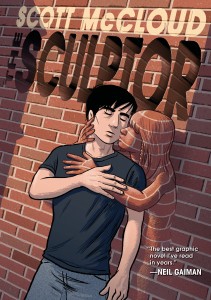
Although the last bit left me a bit less than 100% engaged, the majority of the book had me cancelling plans so I could continue reading. Overall, it’s a major graphic accomplishment, one that is both a compelling page-turner and a relevant meditation on life, art, and love, presented by one of the most important cartoonists of our time. It’s certain to be the start of many best of 2015 lists, and despite my issues with it, I can’t say I wouldn’t consider it among the better graphic novels in the last several years. The Sculptor‘s careful storytelling and alluring art far outweigh the narrative problems that slowly creep in towards the last part, and in the end, it’s a book I would strongly recommend with just a few qualifiers.
The Sculptor releases on February 3rd. If you act fast, you can still order signed copies through Barnes and Noble. See ScottMcCloud.com for details on the book tour.
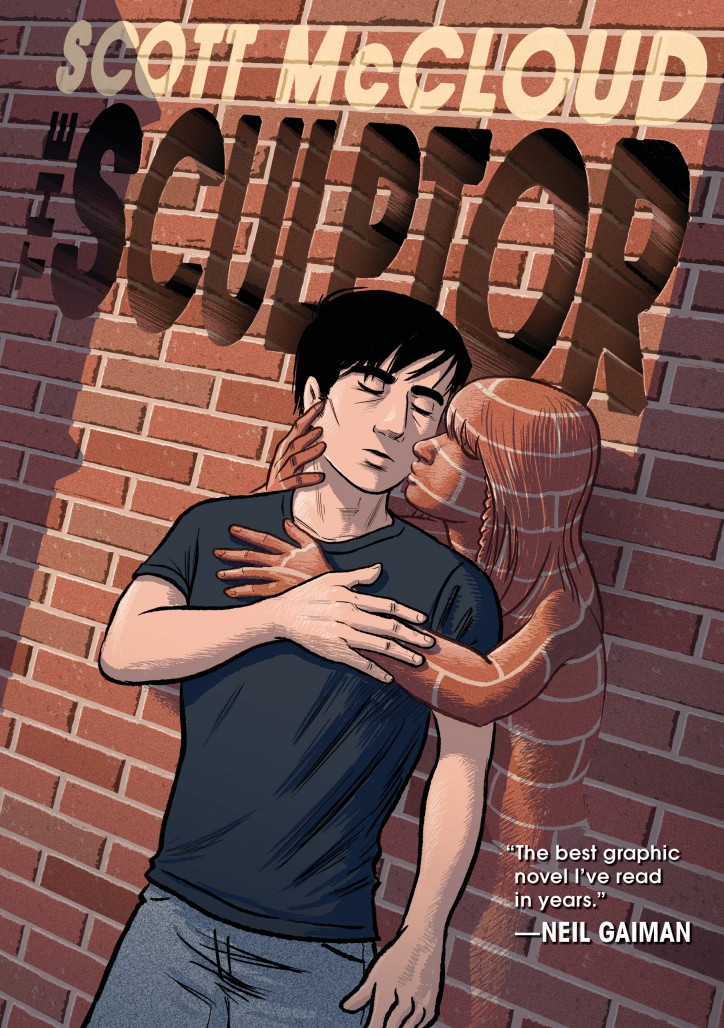
By Harper Harris and Kyle Pinion
In The Sculptor, David Smith is an out of work artist, who feels as though he never quite reached the level of fame he always thought was right within his grasp. When the physical representation of Death comes offering a deal: the power to sculpt anything he can imagine with his bare hands with the caveat that his life ends in 200 days, David cannot resist the possible benefits of such an ability. The after-effects that this bargain has on his friends, New York City, and his love-life become the center-piece of this newest graphic novel by acclaimed cartoonist Scott McCloud.
30 years in the making, McCloud’s new opus is available on February 3rd through First Second. McCloud was kind enough to sit down with us for a lengthy discussion about the new book, critical expectations, his creative process and how he balances his busy speaking schedule and the creation of a 500-plus page graphic novel.
Kyle: How is the press circuit treating you? I know you’ve been on interviews for weeks now. Are you exhausted?
Scott McCloud: No, I store energy like a cactus stores water and five years squirreled away in my hobbit hole drawing, you store up a lot of energy. So I was definitely ready to come out into the sunlight and talk to people. And the reception so far has been amazing. So far it’s been really encouraging I think is what I mean to say.
Kyle: Well, that’s good to hear. That actually pivots over to one thought that I was curious about. Over the past 15, 20 years now, though you’ve of course published books like Zot! and you did some work with DC in the past as well on the Superman Adventures, you’ve been known as the guy that breaks down comic book storytelling via Understanding Comics and the like. With critical response in mind, did you ever feel a certain level of pressure as someone expected to live up to that analysis with The Sculptor?
McCloud: Oh yeah. There was definitely a big target on my chest when I did this thing, but it was a good kind of 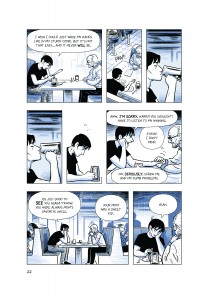 pressure. The pressure was pretty strong after Understanding Comics, that anything I did in the way of fiction afterwards would be judged with that in mind. I did one or two pieces of fiction that are best left forgotten, that didn’t do so well. But after Making Comics, there was definitely a bulls-eye on me because I wasn’t just telling people how to read them, I was telling people how to make them. I had to put my money where my mouth was. But in the end, I thought that was a really healthy kind of pressure because it meant that failure was not an option. I had to really give this my all and I was lucky enough to have an editor who had the same attitude about it and gave me a little extra room, a little extra time to do so. This was originally going to be a three year book and we allowed it to grow to five years with his blessing because he felt that we could pull off something really wonderful. But yeah, I was trying to apply all of these ideas that I had been talking about in books like Making Comics, I’ve been trying to apply them in this work but I’ve also been trying to make sure that they’re hidden, transparent, not on the surface. I didn’t want people thinking about panel transitions and compositions and my use of bleed while reading the thing. I wanted them to be thinking about the story and I hope that’s the effect people will have in the reading experience.
pressure. The pressure was pretty strong after Understanding Comics, that anything I did in the way of fiction afterwards would be judged with that in mind. I did one or two pieces of fiction that are best left forgotten, that didn’t do so well. But after Making Comics, there was definitely a bulls-eye on me because I wasn’t just telling people how to read them, I was telling people how to make them. I had to put my money where my mouth was. But in the end, I thought that was a really healthy kind of pressure because it meant that failure was not an option. I had to really give this my all and I was lucky enough to have an editor who had the same attitude about it and gave me a little extra room, a little extra time to do so. This was originally going to be a three year book and we allowed it to grow to five years with his blessing because he felt that we could pull off something really wonderful. But yeah, I was trying to apply all of these ideas that I had been talking about in books like Making Comics, I’ve been trying to apply them in this work but I’ve also been trying to make sure that they’re hidden, transparent, not on the surface. I didn’t want people thinking about panel transitions and compositions and my use of bleed while reading the thing. I wanted them to be thinking about the story and I hope that’s the effect people will have in the reading experience.
Harper: To delve into The Sculptor itself and how you got started with it, one of the concepts in the book is just how David, an out of work sculptor, feels like he’s got this unrealized potential…he’s got all this creativity stored up and then he feels like he can be this big famous sculptor but he doesn’t have the means to do it yet. As a writer, when you were getting started with this project, do you feel like your creative soul was restless or you had something big you had to accomplish and you just were ready to get it out?
McCloud: I felt like that when I was in my 20s. When I was the same age as David, I felt a lot more like David than I do now. I’ve been lucky because I’ve actually gotten some attention and I’ve been able to get my work out there, but I have a lot of feeling for those who don’t have that, who haven’t had that luck. Whether they’re young and just starting out or if they’ve been at it for 30 years, there are a lot of people who have trouble getting their work out into the sunlight and who rightly feared that their work might be forgotten someday, maybe even in their lifetime. Something that happens to a lot of artists is being forgotten in your lifetime. I can easily put myself in that mindset again of imagining that and imagining that fear, the fear that comes with that. And then the fact that David has this family that’s already gone, both in terms of their physical lives but also in terms of the memories of them, even though they were all three very creative people, his parents and his sister. That made it a much more urgent need on his part to not be forgotten.
Kyle: Now this is a concept that you created decades ago. I think I heard once it was about 30 years ago, is that correct?
Scott McCloud: Yeah, it was really terrifying when I realized it was 30. I was saying 20 and then I think it was Ivy, my wife, just reminded me “nah, it’s actually more like 30.” That’s a long time!
Kyle: It’s a concept that’s older than Harper here actually.
McCloud: It’s older than a lot of readers. It may be older than most of the people who will read this book, some may be younger than the idea for the book itself.
Kyle: I wonder, how has your life experience changed the way you’re approaching the material than if you had written it back in 1980, whatever year it was that you initially thought of it?
McCloud: Well, I think it’s a better book for having been written much later but the important thing for me was I had this young man’s idea and had had a lot of the things we associate with young ideas. It has lots of bold, preposterously ambitious ideas in it. It’s trying to address questions of life and art, mortality, the nature of existence and that sort of thing. I think as we get older, we’re more likely to just address the struggles of getting your coffee in the morning and going to a job you hate or whatever. People tend to scale down their ambitions a little. My goal for this one was to see if maybe I could take that young man’s idea and capture the enthusiasm I had when I was a young man and channel that crazy ambition but channel it in a direction that was informed by the perspective I’d gained as an older man, nearly twice the age that I was when I first came up with it, when I started to work on this thing. And hopefully I’ve been able to do that. To not castrate it, not rob it of the vitality of that young idea but try to preserve the vitality while giving a perspective, direction and a more meaningful shape through what I’ve learned in the intervening years.
Harper: Being that this was an idea that gestated for such a long time and you added things and changed things as you were thinking about it, when you actually sat down to start putting pen to paper and writing it, what was your process like? Were you coming up with a script first, or was it just a rough draft, or were you doing thumbnails?
McCloud: The first part of the process was when I realized I really wanted to work on this book, it was just as I was starting a 50 state tour in support of that previous book, Making Comics, 2006 and 2007. And I was so desperate to 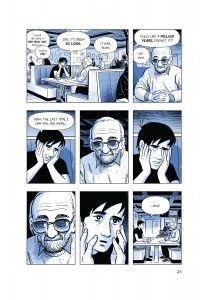 work on The Sculptor but all I could really do was sit in the passenger seat while my wife drove. I’m not allowed to drive. I’m a terrible driver. And just think about it for a year. And in a way, that was actually really good. That first part of the process was just thinking about the story and taking lots and lots and lots of notes. Then I got to work in earnest after we had a publisher and we were ready to start active work on the thing. I started to create the layouts and for the first year, I did nothing but create these layouts which were – my layouts are pretty tight. They look a lot like a finished comic, just a rough version. But all of this takes place before there’s any finished art, right? So I make this thing, I make the whole thing. I send it to my editor, Mark Siegel. I also send it to my “five kibitzers” as I call them – friends who I know will be honest and tell me what parts suck, whatever parts of the story don’t work. And then I revised it based on their input and I revised it again and I revised it again. I did four revisions of this nearly 500 page book in layout form. Took me two years. This is all before I ever drew a single finished panel. And then I started drawing the real thing and that took three years. It took me three years to draw those near 500 pages and that was done on my Cintiq tablet in Photoshop. It’s entirely digital even though it has that slightly rough hand-drawn quality to it, the entire thing was done digitally. In fact, the layouts were all done digitally too. 40 pages at a time in a giant Photoshop document.
work on The Sculptor but all I could really do was sit in the passenger seat while my wife drove. I’m not allowed to drive. I’m a terrible driver. And just think about it for a year. And in a way, that was actually really good. That first part of the process was just thinking about the story and taking lots and lots and lots of notes. Then I got to work in earnest after we had a publisher and we were ready to start active work on the thing. I started to create the layouts and for the first year, I did nothing but create these layouts which were – my layouts are pretty tight. They look a lot like a finished comic, just a rough version. But all of this takes place before there’s any finished art, right? So I make this thing, I make the whole thing. I send it to my editor, Mark Siegel. I also send it to my “five kibitzers” as I call them – friends who I know will be honest and tell me what parts suck, whatever parts of the story don’t work. And then I revised it based on their input and I revised it again and I revised it again. I did four revisions of this nearly 500 page book in layout form. Took me two years. This is all before I ever drew a single finished panel. And then I started drawing the real thing and that took three years. It took me three years to draw those near 500 pages and that was done on my Cintiq tablet in Photoshop. It’s entirely digital even though it has that slightly rough hand-drawn quality to it, the entire thing was done digitally. In fact, the layouts were all done digitally too. 40 pages at a time in a giant Photoshop document.
Harper: Why is sculpture was the main thrust of the book as opposed to him being a painter or something that was a little bit maybe closer to your own craft?
McCloud: Well on the one hand, sculpture makes good visual theatre in the sense that it exists in three dimensions, it’s dynamic. The idea of going up against that hard surface, in the case of the sort of things that David is doing, has a nice sense of explosive physical conflict to it. But beyond that, the choice of sculpture as opposed to any other form, I have to be honest, I never even considered anything else simply because that was the starting point. That that was this idea in its original state as it existed in that little three ring binder that I have been carrying around with me since high school where I would write down ideas. That’s where it began, the idea of a sculptor in particular. I don’t really know if it would be quite as effective if it were say flat visual arts like painting or drawing, although interestingly enough, a book that I really enjoyed, Dylan Horrocks’ Sam Zabel and the Magic Pen is I think coming out around the same time and in a way, he does have that notion of the artist being given supernatural abilities of one sort or another, in his case through literally a magic pen. So he gets to explore a slightly different side of that artistic deal with fate.
Kyle: Did you have to do any sort of background research at all?
McCloud: I researched the art world in that area as far as just the cultural and business aspects of it and then just looked at a lot of sculpture. But in the end, I think it’s important to note that what David makes in many ways fails. It fails the test and he’s unable to get a wider audience for it for much of the book. The only things that David ever makes that gain the favor of that world, we don’t actually see. We don’t see the work he makes before the story begins that had gotten him some attention early on, we don’t see the work that he makes that his friend Ollie considers very promising. That stuff is off panel. What I felt I was able to draw or what I was able to imagine is the sort of work that a sculptor might not get recognition for. And so I was able to just pour my crazy imagination into it and then knowing that I wasn’t presenting this as some kind of masterpiece that would be universally acclaimed, I was presenting his sculpture as something that would probably confound or be uninteresting to that world. But I did research some of the experience of living in that world, talked to a couple of people who are part of it. In large part, I was just researching what it is to live in New York in 2000 something because of course this took place over several years and just try to get the city right, just try to show the physical environment of the city as well as the cultural environment.
Kyle: In order for David to gain his amazing abilities, he had to strike a bit of a Faustian pact with the embodiment of death. Do those type of stories fascinate you? It’s basically the fulcrum that this story into motion, at least in the beginning stages before we get to know the characters better. Do you find yourself a fan of tales like The Devil and Daniel Webster and the like?
McCloud: Now that you mention The Devil and Daniel Webster, I actually really enjoyed that but it’s been literally 40 years since I’ve read that one, but I remember really being into it. I don’t know that the story was in any way commenting on those other stories, but in some way, I think the important departure here is that it is a deal with death and that the ultimate result is still oblivion, as shown in the blank pages towards the beginning of the story. Like most Faustian bargains, the ending is not in question, right? You know the final fate of the character. But this time, because of that notion of oblivion rather than eternal damnation, it’s kind of the secular version of that story, isn’t it? And I think understanding the difference between that secular, updated version and versions that are more tied to questions of morality than to questions of existential terror, that was interesting to me. I think that was the main thing was that the way in which the echoes of religious beliefs were resonated a bit through this story, but of course it’s a profoundly non-religious story despite the supernatural element that sets it in motion.
Harper: David can be frustrating at times when he is making the wrong choice, which he does quite often. Did you find it difficult to write a protagonist that has those flaws?
McCloud: Well interestingly enough, David was even less likeable in early drafts of the layouts. A lot of my friends who were reading it over, and my editor, pointed out ways in which he was a difficult character to get into. You can have a character with very negative aspects to their personality who audiences still have a passageway into. That was my goal primarily was that even when David is being frustrating, I wanted my audience to be able to get inside his head, to see what it was like to be him from the inside. It goes in a slightly different direction from the question of likeability. Relatability and likeability, I’ve come to understand are two slightly different things when writing characters. He had to be relatable first and foremost and that was one of the goals that I internalized when I was going through rewrite after rewrite, to make sure that we could understand where he was coming from, and to get a sense of what drove him forward even when he was being frustrating or stubborn. Part of that was understanding the difference between wanting to be remembered and being terrified of being forgotten. They’re two different things. Understanding that difference, I think, was one of my crucial procedures as I constructed and reconstructed this story.
Kyle: I’d like to also talk a little bit about one of the other key themes that hit me while I was reading, you display clinical depression in this book with a lot of nuance and that’s not something you see done particularly very well in really many forms of media – television, film, comics, whatever we might be talking about. How much thought and work went into giving that characteristic to that particular character – or was there personal experience at all involved there that sort of informed how that character was resolved?
McCloud: Yeah, there was a lot of personal experience that went into that and that was crucial to being able to capture those thought processes and the kind of relationship that one might have with somebody going through that. I think in early drafts it felt a little bit more pat, a little bit more like just a mechanical necessity of the plot and I think it gained in resolution and nuance I think with the rewrites. That was something that we were very concerned with, that it not simply be a plot device but that it be part of the texture of the story without necessarily departing from what the story was about. One of the things about getting increasing specific in the portrayal of something like that is that you don’t want the story to become about itself, you don’t want to lose sight of why the story exists in the first place. And so that was the balancing act, making sure that this felt like a real emotional story but an emotional story that existed within the universe of the ideas of the story as a whole.
Kyle: This is strange to say, but it’s probably my favorite part of the book because it felt so real to life.
McCloud: That’s really cool. I have to say, much of what I was doing there was channeling because sometimes when you have direct real life experience, sometimes you just close your eyes and let a character speak from experiences. You can hear the voice in your head. You know what words come next because it’s part of the texture of your own life. It’s not a trick you can do often because you – unless you have profound relationships with many, many people which I suppose normal people do. Maybe that’s just me speaking as an overworked comic artist that I’m only able to slot in a few in the course of a lifetime.
Harper: Looking at taking the writing process into the art process, how much thought goes into the panel to panel storytelling, or the perspectives that you choose, or whether you’re going to have an establishing shot to set the mood first, or whether you just go back and forth between the two characters?
McCloud: Every single composition, every single panel choice and pacing choice was done very deliberately, but always with the goal that it wouldn’t seem deliberate. I wanted this book to feel as if it 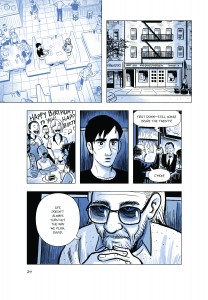 had just written itself, so transparency was the goal. One what that I tried to do that was by being very rigorous about capturing the rhythm of ordinary conversations, right down to the silence is something that Mark Siegel encouraged me to do. Sometimes it’s important, those pauses between speech are vitally important to capturing a credible rhythm of speech. Something that a lot of comics feel they don’t have the time to do, especially if you’ve got a 23 page story, having a panel of somebody just in between sentences, taking a sip of coffee or something, you’re not going to see that. And yet that’s something that we intuitively recognize as the music of humans in conversation. And when we recognize it, they become real. And when they become real, you stop thinking about panel transitions, you stop thinking about composition choices, you stop thinking about bleeds and you are lost in the world of the story. The first line of offense in conquering the reader’s perception of a real illusionistic world inside that story is the way people act with other people. You get that right and you’re more likely to be able to cast that spell and keep readers in the story.
had just written itself, so transparency was the goal. One what that I tried to do that was by being very rigorous about capturing the rhythm of ordinary conversations, right down to the silence is something that Mark Siegel encouraged me to do. Sometimes it’s important, those pauses between speech are vitally important to capturing a credible rhythm of speech. Something that a lot of comics feel they don’t have the time to do, especially if you’ve got a 23 page story, having a panel of somebody just in between sentences, taking a sip of coffee or something, you’re not going to see that. And yet that’s something that we intuitively recognize as the music of humans in conversation. And when we recognize it, they become real. And when they become real, you stop thinking about panel transitions, you stop thinking about composition choices, you stop thinking about bleeds and you are lost in the world of the story. The first line of offense in conquering the reader’s perception of a real illusionistic world inside that story is the way people act with other people. You get that right and you’re more likely to be able to cast that spell and keep readers in the story.
Kyle: In looking through the panel compositions, it seems like there’s a push and pull between the opaque and the transparent and one of the things Harper pointed out to me was this really interesting use of how you show distance, utilizing either opaque figures or transparent figures, or to emphasize perspective and focus. Was this a tool you consciously decided to use on the book as a visual theme or is this just a natural part of your storytelling tools?
McCloud: Yeah, I think that’s something that I’ve wanted to try out for a long time but I don’t really know that I ever had the opportunity. Nothing I’d done before would have been appropriate for that particular technique. Part of it is the fact that we have a POV character and with a POV character, you can play with perception and emotion visualized in a way that you can’t with a third party objective: omniscient viewpoint. It’s very manga. Manga was interesting to me for a lot of reasons when I first got into it in the 80s and one of the reasons I liked it was that notion of emotional and perceptional participation. That sense that you are here, you’re part of the story. You are the protagonist. And that was done in a number of ways, sort of sliced up aspect to aspect, pieces of perception of the world around you or moving along with the moving character rather than just watching the character move. There were also all of these emotional expressionistic techniques. If the character was nauseous, for instance, the whole world might become a little bit wobbly around them because you were perceiving the world through their eyes. So I tried to do that and I found with the two colors, there were lots of opportunities to do that. As you mentioned, through transparency, opacity, by using colored contours rather than black contours. I think 100 years of CMYK printing tends to condition us to always have a black contour, but there are plenty of reasons not to. So I use them as depth cues and I use them as you said to indicate the perspective of the character, like when he’s focusing on one particular person at a party and everybody else is dimmed out because we’re seeing his mental map of what matters and what doesn’t.
Harper: I know a lot of your work in the past has been black and white. Was there ever a stage that this book was going to be in color or a different style of color use than the way you used it in the book?
McCloud: No. There were practical considerations of cost but there was also the creative considerations that I really like to do it all myself and I’m a shitty colorist. I’ve never had a good color sense and it looks good to me and then everybody else tells me, no Scott, that’s not good, so. But I can choose from a Pantone swatch book, that I can do. And two colors to me is just a little bit nicer than one because with that second color, I can use it not only for the techniques we talked about but just for the simple utilitarian task of clarifying form. When you have that second color, you can make it more quickly obvious to the eye, even at a casual glance, what the forms are on the page, where are the faces versus the background, where the figures and silhouettes are and sense of depth. All of these things really come into sharp, immediate focus when you have that second color. So there were a lot of reasons to go for it.
Harper: In picking the light blue tone that permeates the book; was that a difficult choice or was that something that as you were working through the art, that was just the obvious choice?
McCloud: Actually in May, when time had pretty much run out and it was time for Scott to pick the damn color, I was in Atlanta at the offices of a company called MailChimp. I had given a lecture there either that day or the day before, I’ve forgotten which. And they very kindly gave me their Pantone swatch book and an hour or two in a quiet room in the offices to just sit and select which color it would be. And I will forever be grateful to MailChimp for saving my ass because my Pantone swatch book was locked up in an office here in California, the office I’m sitting in right now. I had the key in Atlanta and there was nobody there who could go and retrieve it for me and those things are expensive, so thank god that MailChimp came to my rescue and gave me that Pantone swatch book and I was actually to select the magical hue 653. I will never forget that number.
Kyle: Between Serial and Scott McCloud giving them praise, MailChimp is having a great couple of months here. I’m trying to couch my next question as carefully as possible here, because it deals with sort of the latter half of the book.
McCloud: Sure.
Kyle: The actual production of the art towards the end, especially in a selection that is full of a lot of panels, was that a physically stressful piece to produce, especially if you were producing it multiple times in multiple drafts? I’m referring to the very end of the book.
McCloud: Oh yeah. No, I know what you’re referring to and it was tremendously difficult, but it was a kind of difficulty that I had come to relish. I really loved the hard work. The hard work of this book was gratifying work. I loved working hard, I loved being challenged, I loved being forced to do something that I had never been able to do before. That was great. What wasn’t great was the fact that I was straining the limits of my system, that it was taking forever to save these files. It was so complex at 1,200 dots per inch – at least I think it’s 12, not 1,000. I think the book is 12 – 1,200 dots per inch, in RGB no less, even though it was a two color book. The thing was just enormous. Those files were enormous. They were like half a gigabyte each and boy, was it slow churning out these things and saving them. That was the hard part was the waiting. Do I save and have to stop drawing for a couple of minutes or do I wait and risk a lightning storm and a blackout or whatever. That was hard, that was hard. But I don’t know, generally speaking though, the hardest things about this book were also the most gratifying because that’s when I felt like I was really finally climbing the mountain.
Harper: One thing I noticed that I really enjoyed in the storytelling was how you used the gutters as far as for pacing. So the distance between the panels in calmer, normal section of the book, there’s a little bit of distance and there are white gutters and then when there’s these parts that are a little more intense or – for example, when David discovers he has these powers and he’s running home to figure out what’s going on and to try them out, the gutters completely disappear and it’s just this thick black line in between panels. It really changed the pacing a lot and the feeling of timing.
McCloud: As you mention it, I’m not sure that I did this much in my first comic Zot!, but there was a pretty rigorous practical set of standards for when that might happen, when I might go to a different gutter style or when I might go to a bleed, for example. And it’s just like for any given moment in the story, the question was: does it pass the test? Is this the kind of moment where David is overwhelmed by what’s happening, where he’s sent into just an emotional rhapsody of one sort or another, of rage or wonder. In those cases, the borders do collapse to a single black line in between panels and it goes full bleed. All of those are full bleed as well. To me, it feels right. And I guess what it is is I had seen other artists who had done that. Sometimes artists just do that for everything. There are a few artists who always have that single black line and full bleeds throughout an entire book. It just has this – I don’t know, it’s like in Wagner when the extra trombones come in. It just seems to be that orchestral color that tells you that something of great weight is happening. And this is a story where I decided to use the full orchestra, so that was one of my tools.
Kyle: I know you speak to a number of different companies professionally, you’re probably on speaker bureaus and the like…
McCloud: Actually you know what, I’ll tell you a secret. I do it all myself. People just email me and I say well, here’s how much it is and I’m either free or I’m not and then we do it.
Kyle: That’s even easier.
McCloud: It’s incredibly informal, yeah. It’s really weird. I should have representation for it. I have representation for Hollywood, I have representation for my books but when it comes to speaking, I don’t know, I just haven’t found anyone that could do it better. It’s weird. So yeah, I just do it all myself. It’s kind of insane. Although I will say for the First Second book tour and my European tour, February, March and April, a lot of that is delegated to the individual publisher.
Kyle: Of course. How do you balance that schedule with your creative time? Is there a lot of creative time being done in hotel rooms? How does that work?
McCloud: We did a lot on hotel rooms last year when we were doing the technical finishes on the book. In fact, I particularly remember writing the entire book to – was it a Holiday Inn in St. Louis maybe or someplace, but we were driving west and we’d stopped for the night and I actually had to unpack my Mac Pro and the Cintiq and everything and it was finally done and we were writing – we got kicked out of our room. So I actually wheeled the Mac Pro out to where the elevators were and Ivy and I were sitting there and while all of these files are being written to a drive, copied to a drive so that we could run to FedEx and send it out. And we looked like homeless people. Our dog was with us and all our coats and we looked like we had camped out next to the elevator and were asking for handouts or something. But all it was was like I had all of this equipment and all of our suitcases just waiting for a file to copy.
Kyle: I’ve never heard of Holiday Inn ever kicking anyone out of a room.
McCloud: *laughs* They were very sweet, they were very sweet. We just explained it and – but it was just nuts. I mean yeah, we’ve had extreme moments like that where it was just really crazy. But as far as the travel schedule versus the work schedule, I worked 11 hours a day, seven days a week for five years, except for the last year where it was more like 14 hours a day. And then I would still travel but in a given month, if I do two or three lectures, that’s really only, what, six days lecturing, traveling and lecturing. So the six days out of 30 is – is that 20%? So 80% of the time I’m working. Of course, Ivy always makes fun of me for this, is that I will say “oh yeah, I was working except when I was traveling.” And she’s like “that’s working too, you know”. It’s not like when I’m hopping on a plane to give a lecture at Google, it’s not as if that’s not work. Of course that’s work. So yeah, I pretty much only work. But then when the book is done, then we have fun, then we play and that’s what we’re going to do this year.
Harper: Was the publishing deal worked out before the creative process or afterwards? I know you had the idea obviously, but was this something that you presented to the publisher and then you went from there? What made First Second the logical choice for that?
McCloud: Well, we went to four publishers and they were all interested in the book to varying degrees. And for various reasons, we went with First Second, but one of the most important reasons of all was just talking to Mark Siegel and seeing that they were willing to put a lot of resources behind it but they also had that sensibility where Mark – Mark is kind of unique. I talked to some real world class editors but Mark has I think the rigorous demanding aesthetic sense of grand, traditional New York 20th century editor while at the same time, also having tremendous chops as an artist and a writer himself. That’s a very unusual combination to find and it turned out to be essential to this particular book, because I really don’t think anybody else could have pulled this story out of me the way that Mark did.
Kyle: What can your fans expect when you’re on the book tour? Will you be speaking at all or will you be displaying any excerpts at all from the book itself?
McCloud: We’re going to be bringing along visuals but for the US tour, the 14 cities in 16 days coming up in February, which’ll probably be this month by the time this goes out. For those where it’s going to be mostly con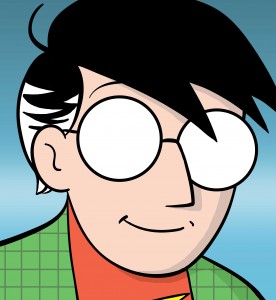 versation format, so I’m going to be in conversation with somebody. But then I’ll have some visuals standing by so I can show process stuff, I can show excerpts, I can show art from the book, things like that. But otherwise, I had suggested that it be conversation format just so that each talk is different. So if you see me in New York or Chicago or LA, each one of those conversations is going to be different and that way if – for the ones that wind up on the web, they’ll all be their own unique conversation which ought to be a lot of fun. But there will still be some visuals thrown in. And I should mention, I’m still doing the full prepared visual lecture thing. That’ll also be happening and already we have about five more talks in the spring that are slipping in between the cracks, even though I’m also going to six countries. It’s kind of insane. We’re doing 14 cities in 16 days followed by England, Spain, Italy, Germany, France and the Netherlands, all of it in February, March and April. But I’ve also managed to slot in talks in Mississippi, Virginia, Ohio and Vermont into that same period and with a couple of others that are about to land as well. Those things that are a bit separate that I’ve arranged for separately, those are going to be the full stand up, hour long visual lecture which has hundreds of images going by very fast and that’s quite a show. These were organized separately, they’re not just a part of the promotional tour, though of course I’ll talk about The Sculptor a little.
versation format, so I’m going to be in conversation with somebody. But then I’ll have some visuals standing by so I can show process stuff, I can show excerpts, I can show art from the book, things like that. But otherwise, I had suggested that it be conversation format just so that each talk is different. So if you see me in New York or Chicago or LA, each one of those conversations is going to be different and that way if – for the ones that wind up on the web, they’ll all be their own unique conversation which ought to be a lot of fun. But there will still be some visuals thrown in. And I should mention, I’m still doing the full prepared visual lecture thing. That’ll also be happening and already we have about five more talks in the spring that are slipping in between the cracks, even though I’m also going to six countries. It’s kind of insane. We’re doing 14 cities in 16 days followed by England, Spain, Italy, Germany, France and the Netherlands, all of it in February, March and April. But I’ve also managed to slot in talks in Mississippi, Virginia, Ohio and Vermont into that same period and with a couple of others that are about to land as well. Those things that are a bit separate that I’ve arranged for separately, those are going to be the full stand up, hour long visual lecture which has hundreds of images going by very fast and that’s quite a show. These were organized separately, they’re not just a part of the promotional tour, though of course I’ll talk about The Sculptor a little.
Harper: The Sculptor is a dense book and it’s got a lot of really big ideas and themes about art and life and love and all sorts of different things. What do you hope is the key takeaway or the key message that you hope readers pull from it as they’re picking it up?
McCloud: Well, there will be a lot of talk about the themes and the ambition of the book. I think a lot of people already are looking at it as a bid for consideration as a big, serious book. But, my very first goal for the book, and in a lot of ways still my most important goal, is just to create something that is an enjoyable read, that’s a page turner, that has a kind of narrative momentum that just carries you from panel to panel and page to page. If I can pull that off first and foremost, I’ll be happy. I want it to be something that people really get into, that’s engrossing, that they can lose themselves in. And hopefully something that they can find as a rewarding re-read as well. That’s a lot of stuff in there that I think will become apparent on second reading and third reading.
Kyle: Is this going to mark a trend of more fiction based writing from you or are you going to return to analysis after this?
McCloud: Actually, my next book will be a nonfiction book and it’s going to be about visual communication and some of the common denominators across different disciplines in terms of visual education. I feel as if there are common principles to data visualization, information graphics, educational animation, and educational comics. People in all of these fields I think are knocking on the same door and I think it might be useful to see if I can discern some of the fundamental principles that lie behind all of those disciplines and put them in one work, so that’s the next project. That’ll also be with First Second Books.
Kyle: Lastly, where can people find information about the upcoming book tour? Will that be on First Second’s website or will that be on your website?
McCloud: It’s on First Second’s website now. I tweeted about it just the other day and as soon as I’m done with today’s interviews, I am so finally putting up a blog post on my own front page at ScottMcCloud.com and updating my side bar, which is still telling you all about the things I did last year. By the time people get to hear this, they’ll definitely be up.
You can pick up The Sculptor in book stores or your local comic shop starting February 3rd.
For those who are so inclined you can also listen to the full audio of the interview below:

Hm let’s see, we need an ambassador of comics who can work with schools, educators and more to show how comics can contribute to literacy and learning. We need someone who is smart, distinguished and universally loved…
I know! Let’s get Dave Gibbons!
And so it has been announced at this year’s Lake Festival which is being held this weekend.
Bestselling graphic novelist Dave Gibbons is to become the first Comics Laureate. The announcement was made by internationally acclaimed comics authority and graphic novelist Scott McCloud at the launch of new charity Comics Literacy Awareness (CLAw) at the Lakes International Comic Art Festival on 17th October.
The role of Comics Laureate is to be appointed biennially to a distinguished comics writer or artist in recognition of their outstanding achievement in the field. Their role is to champion children’s literacy through school visits, training events for school staff and education conferences. Dave Gibbons has won universal praise for his comics and graphic novel work for Marvel and DC Comics including the ground-breaking Watchmen (with Alan Moore), as well as the UK’s own 2000AD and Doctor Who. “It’s a great honour for me to be nominated as the first Comics Laureate,” he says. “I intend to do all that I can to promote the acceptance of comics in schools. It’s vitally important not only for the pupils but for the industry too.” Dave Gibbons takes up his two-year position from February 2015.
Comics Literacy Awareness (CLAw) is a new UK charity formed by a group of passionate, highly experienced professionals from the fields of education and comics. Its primary aim is to improve the literacy levels of children and to promote the variety and quality of comics and graphic novels today, particularly in the education sector.
The Board of CLAw’s trustees includes renowned graphic novelist Bryan Talbot, winner of the 2012 Costa Award for Best Biography for Dotter Of Her Father’s Eyes (a collaboration with his wife Mary Talbot). He says, “In many other countries, comics and graphic novels have been used extensively in literacy drives. The sheer accessibility of the medium, the way in which complex information can be easily absorbed through its combination of words and pictures, actively encourages reading in those intimidated by endless blocks of cold print.”
The other trustees are Julie Tait, Director of the Lakes International Comic Art Festival; Ian Churchill, comic book artist for DC and Marvel, and writer/artist on his Image Comics title Marineman; Emma Hayley, Managing Director and Publisher of UK’s independent graphic novel company, SelfMadeHero; Paul Register, school librarian and founder of the Stan Lee Excelsior Award; and Dr. Mel Gibson, comics scholar and senior lecturer at Northumbria University.
Alongside the Comics Laureateship, CLAw will work closely with schools on a number of initiatives, including staff training events and classroom visits by comics professionals. They will liaise with museums and galleries on a variety of comics-related projects, and provide reading lists and general guidance to school staff and parents unfamiliar with the comics medium, demonstrating the wider educational benefits it can offer.
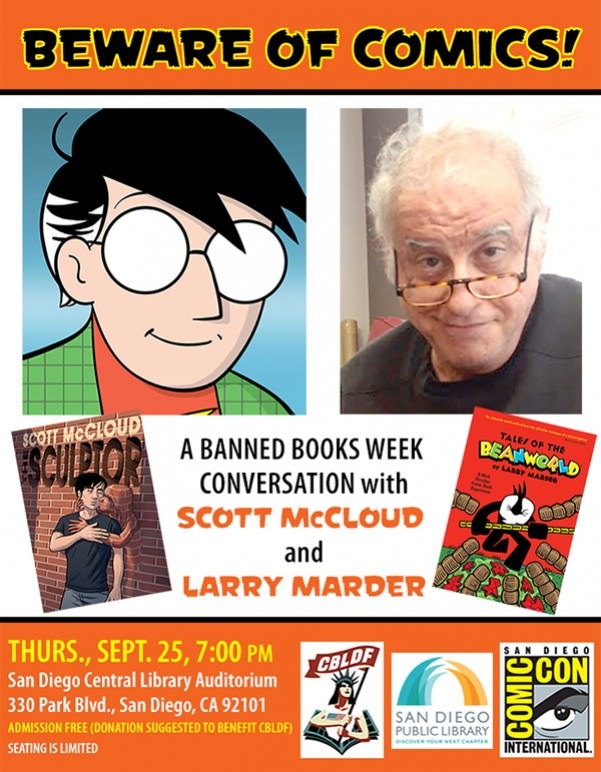
It’s Banned Books Week, a n annual event mostly held in libraries which spotlights attempts to remove books. This year’s theme is graphic novels, as discussed in this article from PW by Rich Shivener. The Comic Book Legal Defense Fund is sponsoring several events this week and has much more information and a list of banned or challenged comics here. The idea for GNs as a focus started when last year it was announced that the top ten challenged books nationwide includes Bone by Jeff Smith.
Tonight’s big event is a discussion by Scott McCloud and Larry Marder, co-sponsored by the CBLDF, Comic-Con International and the San Diego Central Library. Needless to say, if you’re in the area, it’s worth a listen.
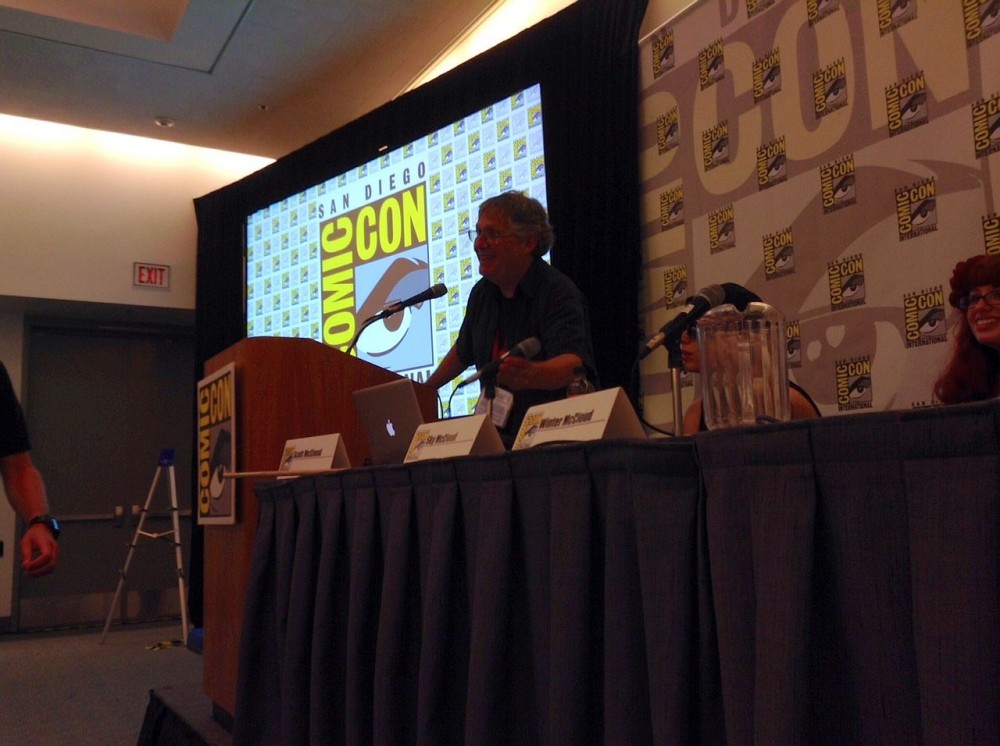
Scott McCloud charming the crowd while he figured out some technical difficulties.
Thursday was a good day if you’re a fan of the Scott McCloud. McCloud and his adoring family rushed from his insightful panel with Gene Luen Yang. The rooms couldn’t have been farther apart, and the technical difficulties didn’t help. Luckily, his daughters Winter, Sky and wife Ivy accompanied him in the thick of things.
The comics theorist revealed the cover art Jaime Hernandez drew for his upcoming book “The American Comics” that will release on Tuesday, Oct. 7. McCloud asked that the audience refrain from taking pictures of pages from his upcoming book The Sculptor. He teased some intriguing pages that we won’t see again until (forever from now) Feb. 3 2015. The book is a 500 page love story about a sculptor named David Smith (no relation to actual American Abstract Expressionist sculptor and painter) that made it big at a young age, but the fame and fortune didn’t last long. He makes a deal with death so he can create anything he could phantom, but he will only have 200 days to live. With nothing to lose, Smith accepts the deal. But Smith didn’t anticipate meeting the love of his life.
McCloud wanted to dispel the rumor that has been floating around how long he’s actually been working on this book. McCloud said he came up with this idea in high school. “I couldn’t get the idea out of my head because it became a real story,” McCloud said. He heard that someone says he has been working on this book for 30 years or something ridiculous, but this book has been in the process for only five.
McCloud and his family read excerpts from the book. It was reenactments were dramatic enough to get some gasps and complete silence from the end of the reading. It was cruel for them to flaunt this powerful scene, and left the room begging for more. The characters are inspired by actual people in McCloud’s life. McCloud discussed the character’s desire and how important it is to the story. “I’m trying to find desires and a path that hasn’t been seen before,” McCloud said. “It takes it the edge of reason and beyond.”
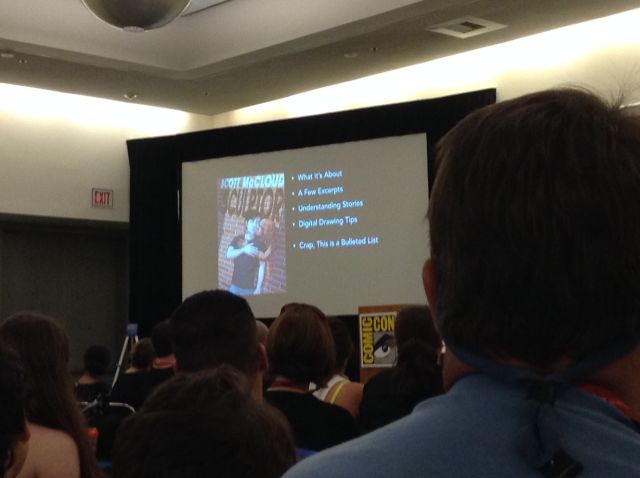
The panel was starting to come to a conclusion, but McCloud took a few questions because of the late start. Someone asked “The Smartest Man in Comics” what the future has in store for the medium. He said he predicts that there will be an increase of female comic book creators. McCloud said the cross-legged manga generation that spent a lot of time at Borders have since went on to art school.
“Is it possible that 10 years from now the industry will be female majority? I think so,” McCloud said.
McCloud is hosting the fourth annual two-day comic book workshop on theory and practice on Saturday, Aug. 16 and Sunday, Aug. 17 at the The Los Angeles Academy of Figurative Art, 16926 Saticoy St. Van Nuys, CA. Click here to sign up.
COMICS! remember that? First Second has announced its Winter ’15 slate, which includes not only the LONG AWAITED new book by Scott McCloud, but new books by Jay Hosler, James Sturm, Andi Watson and the English language debut of Bastian Vives’ very popular (on the continent) Last Man series. And the next volume in George O’Conner’s Olympians series.
Hosler, in articular, is a scientist/cartoonist whose Clan Apis of years ago was one of the first modern “practical” comics, and his work crosses over between education and entertainment without slighting either. Andi Watson is also a very prolific and charming cartoonist whose work we haven’t seen from a major publisher in a while.
Here’s some capsule loglines and covers:

The Sculptor, by Scott McCloud – we can’t wait to share this wonderful graphic novel full of magical realism with you! We recommend you check out what the New York Times had to say about it. Or USA Today.

The Last of the Sandwalkers, by Jay Hosler – this world full of beetles is about to discover that other new, dangerous, and exciting life forms exist.
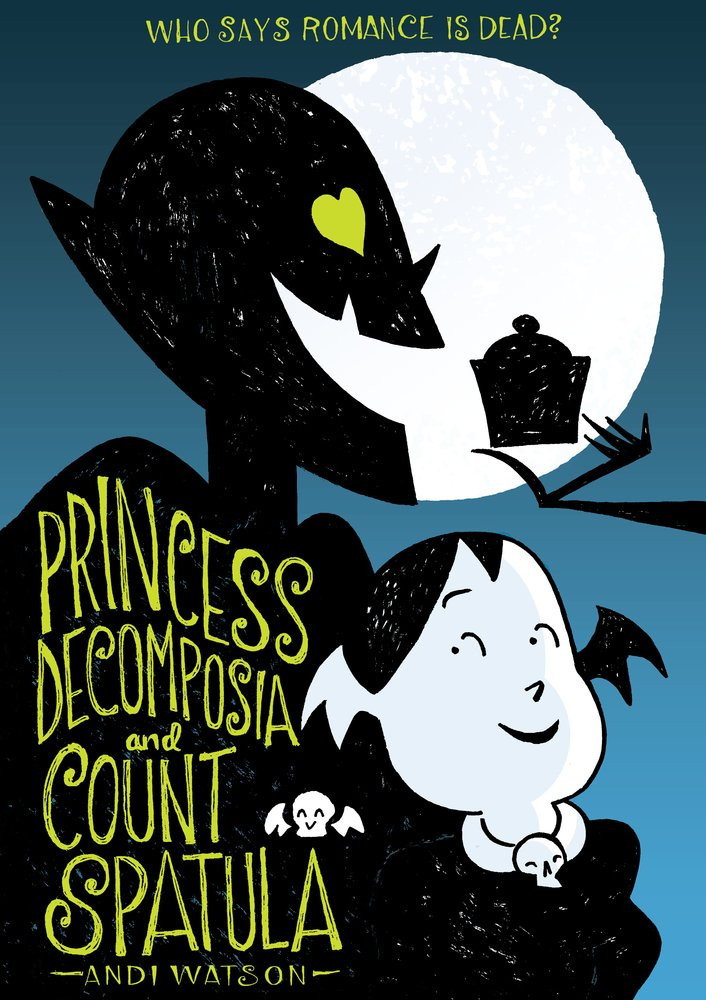 Princess Decomposia and Count Spatula, by Andi Watson – when Princess Decomposia begins to run the underworld, she’s going to need some help . . . and who better than a vampire chef?
Princess Decomposia and Count Spatula, by Andi Watson – when Princess Decomposia begins to run the underworld, she’s going to need some help . . . and who better than a vampire chef?
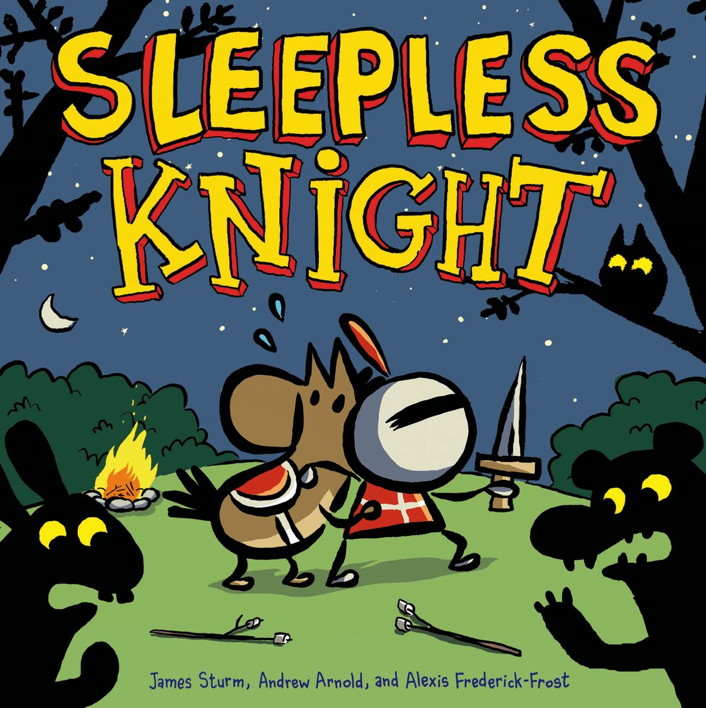
Sleepless Knight, by James Sturm, Andrew Arnold, and Alexis Frederick-Frost – the first Adventures in Cartooning picture book comic is adorable, and full of knights and marshmallows and adventure!
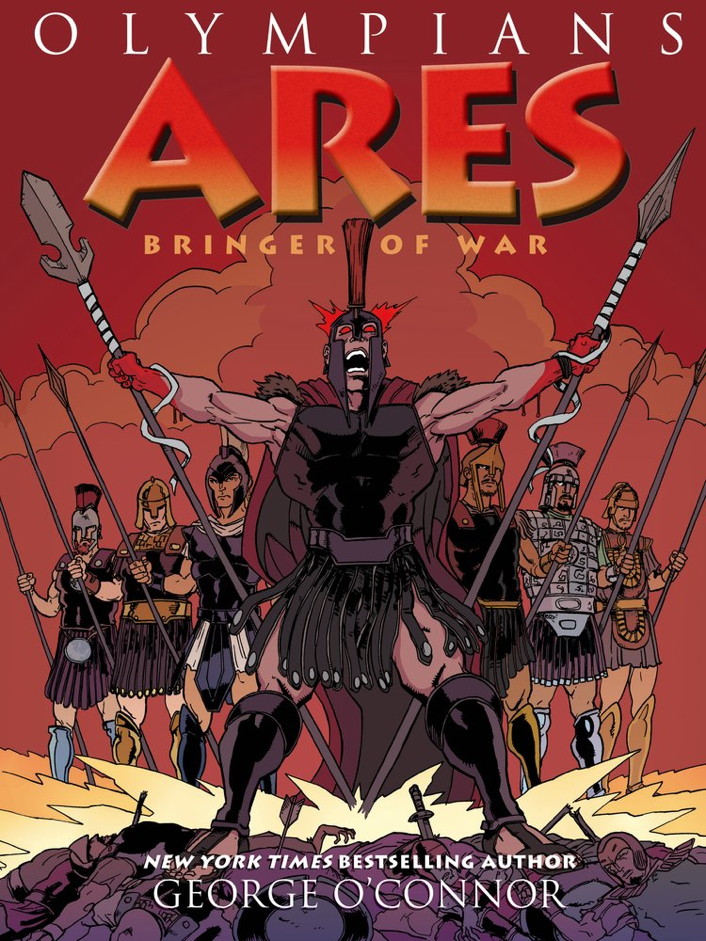
Ares: Bringer of War, by George O’Connor – it’s the Trojan War, from the perspective of the pantheon of Greek gods instead of the mortals.

The Stranger, by Bastien Vivès, Michaël Sanlaville, and Balak – the first volume of the Last Man series, these books are filled with magical-medieval combat possibly in another dimension.
Reminder: Other :01 Upcoming 2014 Titles
(there’s still some of this year left to publish books in, it turns out)
The Shadow Hero, by Gene Luen Yang and Sonny Liew; How the World Was, by Emmanuel Guibert; The Zoo Box, by Ariel Cohn and Aron Steinke; Julia’s House for Lost Creatures, by Ben Hatke; The Wrenchies, by Farel Dalrymple; Above the Dreamless Dead: World War I in Poetry and Comics; The Rise of Aurora West, by Paul Pope, JT Petty, and David Rubin; Olympians Boxed Set, by George O’Connor; In Real Life, by Cory Doctorow and Jen Wang.

Every year seems to bring an eagerly awaited, long brewing graphic novel by an industry master — and in 2015 that book looks to be Scott McCloud’s The Sculptor, which has been in the works for years and years. It’s currently slated to be released in February, and USA Today has the first look at the cover as well as some chat from McCloud on the subject matter:
Arriving in February, The Sculptor (First Second Books) stars a once-promising artist named David, who’s already washed up at 25. He makes a deal with Death to be remembered, and David’s given 200 days of being able to sculpt anything with his bare hands.
However, he then tumbles headlong into a romance forcing him to question what he wants from his life as well as his art.
“It’s big, loud and operatic at times, but also grounded in a lot of small, funny, human moments,” McCloud says. “Most of all, I just want it to be an engrossing read — a page-turner from beginning to end.”

The NY Times has the first official look (aside from iPad sightings over the years) of Scott McCloud’s The Sculptor, his first sustained fiction in quite some time. First Second, the publisher, also sent along some into including the pub date, February 3, 2015.
The story concerns an sculptor in his 20s named David Smith who makes a deal with the devil, or Death in this case, to be able to sculpt anything with his hands. Unfortunately, Death gives David only 200 days to do something with this power, and there in lies a tale of romance and discovery.
“I’ve wanted to tell the story of The Sculptor since before writing Understanding Comics, and the book’s creation has turned into an incredible learning experience for me and, I hope, an exciting READING experience for comics-lovers. It took me five years to write and draw, and I promise I used every single minute to make it the best book I can,” said McCloud. in a statement.
I know Scott has been working very very hard on this books for years—and it’s also why he’s been in virtual internet silence for at least the last year. I wasn’t kidding about the iPad sightings either. And I know he worked very closely with First Second’s Mark Siegel, who wrote of the project “To work with Scott McCloud on any project of his choosing was a long held hope of mine. But to join him as he sheds the theorist and embraces ambitious, adult fiction—that’s a dream come true. Scott is one of the hardest working authors I know, and he has tasked himself with a very tall order on The Sculptor. The result soars beyond my shamelessly high expectations.”
Guess that’s the first book of 2015 to look forward to, eh.
Tweet In this week’s PW Comics World, I interviewed Jeremy Short—creator of the study on comics comprehension referenced here—about that study and a general overview of current research on how comics affect learning and cognizance. My takeaway: we’ll be seeing more of this. Along the way I chatted with Scott McCloud, who feels that the [...]
TV writer Tim Heiderich and writer/illustrator Mike Rosen hope to raise $2,800 on Kickstarter for Misunderstanding Comics, a project responding to Scott McCloud‘s 1993 graphic novel, Understanding Comics. We’ve embedded a video about the project above–what do you think?
Here’s more about the project: “Join us as we turn a jaundiced eye toward all that is wrong with the ‘invisible art.’ Every innovative idea that still shuffles along past its much- deserved death, every awful web comic that still manages to rack up a million page views with recycled Star Wars jokes, the once great artists and writers who have become caricatures of their former selves, and the new talent ready to discover bold new ways to sell out. You won’t understand comics until you misunderstand them.”
Welcome to our Kickstarter Publishing Project of the Week, a feature exploring how authors and publishers are using the fundraising site to raise money for book projects. If you want to start your own project, check out How To Use Kickstarter to Fund Your Publishing Project.
New Career Opportunities Daily: The best jobs in media.

By: John,
on 8/25/2011
Blog:
DRAWN!
(
Login to Add to MyJacketFlap)
JacketFlap tags:
comics,
documentary,
Scott McCloud,
Jeff Smith,
Richard Thompson,
Dan Piraro,
Kate Beaton,
Hilary Price,
Scott Kurtz,
Ryan North,
Jim Davis,
Dave Kellet,
Fred Schroeder,
Add a tag
Yes, I know. Kickstarter projects are popping up like pimples on a nervous teenager these days, and I know many of us are starting to feel the pinch of constantly being asked to donate to this project or that, particularly while the economy is tanking. Regardless, this one sounds pretty exciting and is very relevant to those of us who draw for a living:
We’re Dave Kellett & Fred Schroeder, creators of the comics documentary STRIPPED. This film is our love-letter to the art form: Bringing together 60 of the world’s best cartoonists into one extraordinary, feature-length documentary. The film sits down with creators to talk about how cartooning works, why it’s so loved, and how as artists they’re navigating this dicey period between print and digital options…when neither path works perfectly. We want this film to capture the extraordinary people behind the comics you love, to show how they work…and ask the question: “Where does the art form go from here?”
(via STRIPPED: The Comics Documentary by Small Fish Studios — Kickstarter)

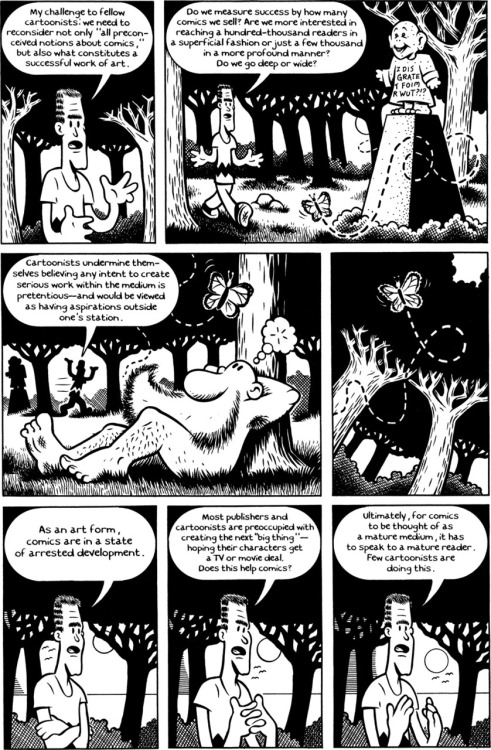
Ben Towle writes on his site:
I’m currently teaching an Introduction to Sequential Art class for The Savannah College of Art and Design and the primary text for the class is Scott McCloud’s Understanding Comics. There’s no denying the importance of this text and I gain new insights on comics every time I read it. I think, though, that it’s important to question and think critically about works likeUnderstanding Comics and not simply accept them as gospel because they’re presented to you as being The Text. To encourage such thinking among my students, whenever I teach a class that has McCloud’s book on the reading list, I always have my students also read Art Baxter and James Sturm’s 1998 response to the book: a short seven-page comic called A Response to Chapter Nine : Build a Beach Head, which ran in The Comics Journal #211 (April, 1999).
With James Sturm’s and Art Baxter’s permission, he has posted the full comic online, along with new thoughts by both creators.

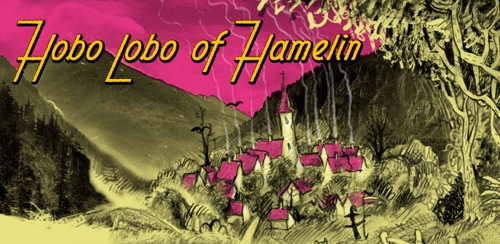
Webcomics are moving forward with more experimentation on the infinite canvas of the browser, and taking new and unforeseen shapes. Here’s one by Stevan Živadinović called “Hobo Lobo” that’s a sidescroller/multi-plane retelling of the Pied Piper tale. Apparently this doesn’t work on Explorer (what does?) but it worked on my decrepit and senile computer, so…happy scrolling!
Link via Scott McCloud; there’s a further discussion of the state of experimental comics in the comment here.
 Google celebrated Will Eisner‘s March 6th birthday with a Google Doodle.
Google celebrated Will Eisner‘s March 6th birthday with a Google Doodle.
The image is embedded above, a logo combining Eisner’s famous hero, The Spirit, and the crowded New York City neighborhoods Eisner explored in later graphic novels. Comic artist Scott McCloud wrote on Google’s blog about how Eisner’s The Spirit newspaper comic influenced many artists, from Jack Kirby to Jules Feiffer.
eBookNewser has more: “Google celebrated the late Will Eisner’s birthday this weekend with a Google Doodle, dedicated to the legendary comic author. Artist Mike Dutton drew the above homage to Eisner, in which the ‘oo’s in Google have been replaced by the eyes of one of Eisner’s most famous characters named ‘The Spirit,’ aka Denny Colt, a crime fighting detective.”
New Career Opportunities Daily: The best jobs in media.
“Do you know that WHAT you put in your panels is potentially far more interesting than how well you DRAW it?”
- Scott McCloud

By:
Mark G. Mitchell,
on 10/14/2009
Blog:
How To Be A Children's Book Illustrator
(
Login to Add to MyJacketFlap)
JacketFlap tags:
"Hex Libris",
Erik Kuntz,
Scott McCloud,
Christy Stallop,
Martin Thomas,
24 Hour Comics Day,
Dragons Lair Comics and Fantasy (store),
Mary Sullivan,
Seraphine,
Zack Proton,
News,
SCBWI,
Dav Pilkey,
Brian Anderson,
Add a tag
Illustrators and comic book creators hunkered down two weekends ago to produce original comic book content. They did this in cities all over the world. It was Twenty Four Hour Comics Day – an annual happening launched some years ago by cartoonist and teacher Scott McCloud, the author of Understanding Comics. (You can read the rules at that link.) This year the event was sponsored by Bawls, one of those caffeinated energy drinks.
In Austin they conclaved at a store, Dragon’s Lair Comics and Fantasy, where lots of tables had been set up for the artists. There were all kinds of things going on in the store that rainy night — people were putting models together, browsing the shelves, visiting their friends.
I wasn’t a participant. Only curious. Plus a pal, cartoonist and writer Erik Kuntz, part of our enchanted SCBWI tribe, was doing the marathon again this year. Erik is the author-artist of Hex Libris, a witty, kid-friendly webcomic with wonderful characters.

Erik's laptop with a panel from his new comic --work in progress.
I don’t do comics much anymore but they were important to me growing up. I read them and drew them.
My own formidable classical education came from reading Classics Illustrated comic books — as many as I could get my hands on. (They were a whole lot better than CliffsNotes.)
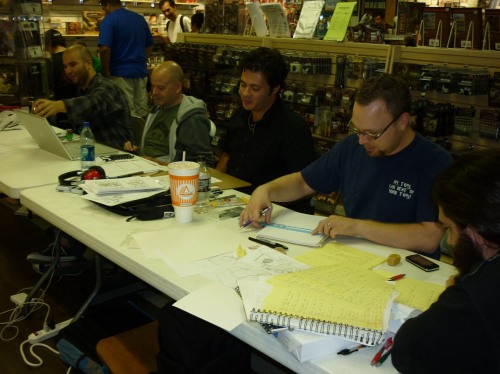
(L. to R.) Bonn Adame, Erik Kuntz, Justin Rogers and Jeremy Guyton create at their table during 24 Hour Comics Day in Austin, Texas recently.
Another SCBWI and Inklings Group pal, illustrator Martin Thomas is a professional colorist of comics.
Mary Sullivan, supremely talented illustrator for Highlights and many other magazines and books and part of our Austin clan — has illustrated a beautiful and funny children’s comic book. She draws in comic panels for her own amusement.
Austin SCBWI illustration chair Christy Stallop does great black and white comic strip panel style illustrations
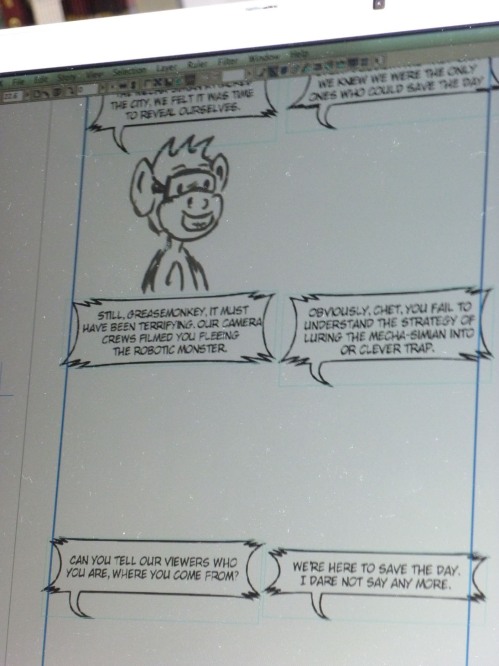
A panel of sketches for "Action Packed Gorillas", a new web comic being developed by Erik Kuntz. The dialogue balloons always come first. (Note: The character featured here is a chimp, not a gorilla.)
My stepson Glenn remains a connoisseur- collector of graphic novels. School librarians are increasingly making room for graphic novels on their shelves. Scholastic Books wants to whip up its own graphic novel brand.
For years the “comic book look” has been finding its way into wildly popular “chapter books ” for upper elementary and middle grades. w. Dav Pilkey is one example. The Zack Proton series by Austin author Brian Anderson (of our SCBWI Mafia family) with illustrator Doug Holgate is another.
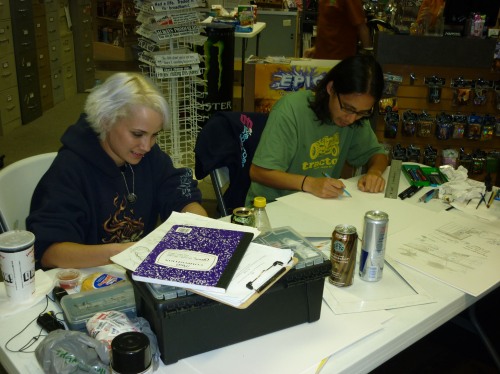
Kads and Matt. Matt has the webcomic http://ayellowworld.com
The Toon Books are comics for toddlers and children just begining to learn to read.
Disney bought Marvel.
By the way, Matt’s blog has a good recap of his experience of the 24 Hour Comics Day here.
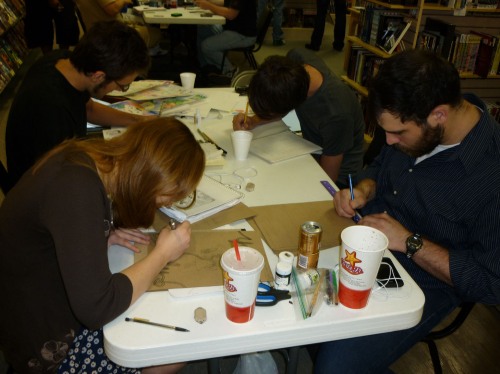
Artist-writer Meghan Regis and technical consultant Jeremy Zunker (an engineering student.) Meghan is the creator of the comic series "Yours Truly" published in "The Paisano", the weekly newspaper of the University of Texas at San Antonio. The main main character in the strip is a young woman who lives on the moon. So seriously, that's why Meghan needs a technical consultant around her when she's working. "Because there are a lot of technical terms that are used in the dialogue," Zunker explained.So
And Yes. Women really do participate in 24 Hour Comics Day. In addition to Meghan (above) there was Kad (who will let me know when she has her website up) and Melanie Moore working on her strip “Sacred Junk” with Amy Middleton (not shown.)
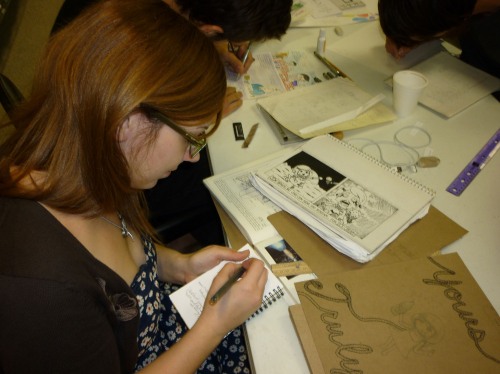
Meghan Regis with her panels.
The teamwork of Jason Poland and Austin Havican ( below) can be seen here and here.
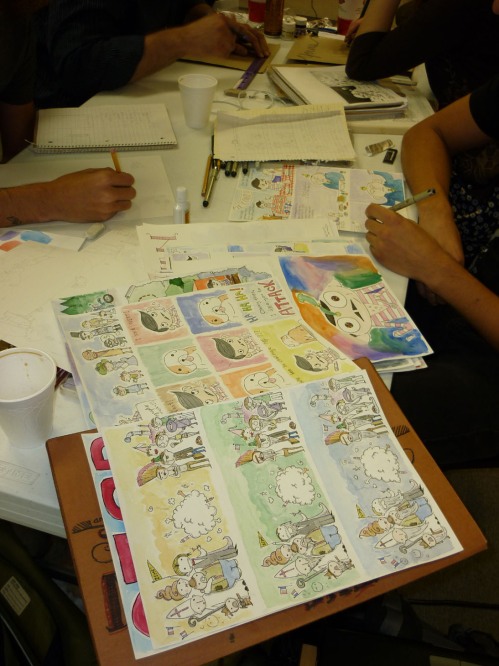
Colored comic panels (watercolor washes) on the comic strip "The Ortolan" created by a collaborative team, Jason Poland, and Austin Havican, whose hands you see here. They described their work as deceptively simple child-like and simply but "definitely not child-friendly." See more of their work at www.robbieandbobby.com. S
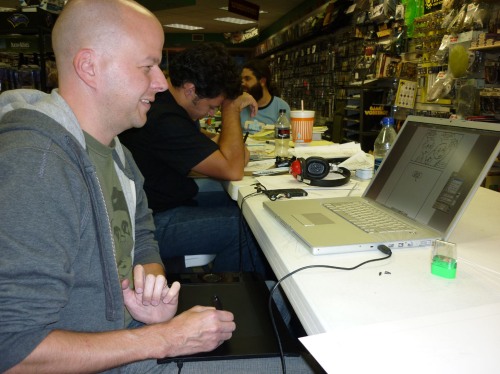
Erik Kuntz laughs at one of his digital cartoons as he draws on a Wacom tablet while Justin Rogers works with traditional comic artist materials -- paper, pencil, eraser, pen, triangle, T-square, etc. (In the background with beard is comics writer Tony Franklin. )
As you see, there were fun moments and lots of hard work– or should I say heart work? I guess they go together — being done by a lot of people in that comic book store.
Erik is suggesting that we get together next year for something a little less intense than a They Shoot Horses Don’t They? draw-a-thon.
He’s calling it the “geriatric version of 24 Hour Comics Day.” I can’t say that I’m in favor of the name. It sounds, you know, a little ageist — and hits a little close. But the idea intrigues. Instead of laboring over pages of comic panels, we could be blitzing through picture book thumbnails and storyboards, or maybe even a dummy.
A children’s book illustrators lockdown. Check back with us in September next year to read our rules.
Seraphine
I don’t want to go without mentioning that I saw the movie Seraphine recently, about an early 20th century painter most of us have never heard of – Seraphine Louis or Seraphine de Senlis.

Seraphine offers an unblinking look at the dilemma of art vs. reality that confronts all artists and would-be-artists sooner or later in their lives.
It’s being promoted as a fictionalized portrait of Seraphine and also of the kindly German art collector who discovered her. But I felt its spirit to be honest. My friend and I were both moved. I recommend that you see it, then give me your thoughts on it. Leave a comment and I’ll share another of mine.
* * * * *
Austin SCBWI illustration chair






We are quite proud of the fact that we offer personalized images inside of our custom kids books. It is extremely important to us that the children receiving our books see THEMSELVES inside, not just their name.

But how did our artists create characters that could be customized to become every child in America (and some very far away countries, too)? A fantastic book called “Making Comics” by Scott McCloud illuminates how, as a default, a reader envisions a character as him or herself. I’ll try to explain with my own horrible drawings.
Imagine a stick figure. We recognize it as an icon signifying a human. Any human. It could be you!
 <— You.
<— You.
You identify with the stickman. Feel his pain. But when we give him a monocle, top hat, and cane, it is no longer you (unless you are Mr. Peanut).
 <— Some jerk.
<— Some jerk.
So it is through each new detail that you begin to differentiate a character on a page as “not you”.
“Okay,” you say, “so you were too lazy to create all the different face shapes, noses, and brows to more accurately match each character to an individual child, so you went generic.”
Not quite. Have you ever seen this piece of art?

If not, I’ll relate how nearly everyone learns about it. The French script underneath the pipe says, “This is not a pipe.”
“Silly French Artist,” you say with a bit of disdain for all people who were berets, “of course it is. Look at it, it looks just like a pipe.”
“But can you smoke it?” asks some snooty art person who’s already in on the joke, to which you sheepishly hang your head, roll your eyes and admit, “Fine. It’s not a pipe. It’s a PAINTING of a pipe.” And then you wait anxiously for the moment you can look smart by explaining it to someone else.
Back to our “laziness”. We realize that anything we put on a page can only be a visual REPRESENTATION of any particular child. Photorealistic detail only underlines this fact, which is why it’s a lot easier to believe that this…
 <— Jeff
<— Jeff
is ME, and this…
 <— Some jerk.
<— Some jerk.
is just plain creepy.
I suggest everyone who has ANY interest at all in comics (funny papers count) to go out and buy or check out from the library “Making Comics” by Scott McCloud. It’ll change the way you see not just comics, but art itself! Check out his amazing lecture on Ted.com.
…

Making Comics: Storytelling Secrets of Comics, Manga and Graphic Novels Scott McCloud
I had to read this for my young adult literature class last summer. While McCloud does have a book,
Understanding Comics, my professor felt that
Making Comics was a better introduction to the art form and how to read them.
Making Comics is a comic book about how comics are made. It talks about the history of comics, the role they play in different areas of the world (they're taken much more seriously in Europe in Japan) and the different styles of comics. Of course, it talks about how to lay out a story, choosing your frames, perfecting your drawing skills, and different tools used and the effects they achieve. Throughout, McCloud animates himself, walking us through these steps and issues with himself as a friendly, funny, and slightly self-deprecating narrator/tour guide.
If you're interested in making comics (or even if you aren't, I totally wanted to be a comics writer after reading this even though I can't draw at all) or are interested in how to read them, why artists make the choices they do, or the history of them, or just want an interesting non-fiction read in comic book form, this one's for you.
Round up is over at Jean Little Library!

By:
Mark G. Mitchell,
on 5/13/2008
Blog:
How To Be A Children's Book Illustrator
(
Login to Add to MyJacketFlap)
JacketFlap tags:
illustrator,
cartoons,
Manga,
Nancy Drew,
cartooning,
Corel Painter,
Adobe Illustrator,
comic books,
Trina Robbins,
Webcomic,
feature interview,
"A Dog a Day",
"Calvin and Hobbes",
"For Better or For Worse",
"Hex Libris",
"Prince Valiant",
"Raising La Belle",
2 Bad Mice Design,
Art School at the Austin Museum of Art,
California State University Summer Arts Workshop,
cartoonist,
child-friendly,
Erik Kuntz,
funny pages,
How to be a children's book illustrator,
kid-friendly,
Lynn Johnston,
Maggie Gallant,
Mark Mitchell,
Scott McCloud,
Add a tag

Who is the creature lurking in the library in Erik’s comic strip? I think I know, and I’ve entered Erik’s contest, but I can’t share my guess with anyone. But I will say this much — it’s a character from a book we know. After all, the strip is Hex Libris, in which Kirby, the main character is charged with taking care of a ginormous enchanted library.
Ever read a novel that just comes to life before your eyes? Well you can expect Hex Libris to take that theme and … ramp it up a little for you.
The serial web comic by designer-writer Erik Kuntz of Austin, Texas began as a New Year’s resolution. So did his illustrator’s blog A Dog a Day that features Erik’s unstop able canine imagery — with a doggy bite of daily commentary. But that’s a subject for the next post.
Erik was thinking of the classic Nancy Drew stories of the 1950’s, mulling how they contrasted and compared with the Nancy Drew graphic novels that are being designed for today’s teens.
“I wondered, ‘What if there was a place where characters could wander out of their books?’ ” Erik says. ”‘And what would happen if the real Nancy Drew ran into the punky Manga style Nancy Drew?’”
Our hero Kirby meets them both as a result of his new archival responsibilities. And so it is inevitable that the trio and who knows who else (stay tuned…) join forces to solve a mystery, or two.
The story unfolds in semi-weekly panels that move us easily, cleanly and sweetly through time and space. We care about Kirby and Amy (a girl who likes him) and girl detective Connie Carter ( the “original” Nancy Drew) and even the little old lady (or is she a witch?) who leases Kirby the uptown apartment that somehow, magically contains a Library of Congress-like basilica within its tiny walls.

It’s an idea Erik hatched at last year’s Summer Arts Workshop at California State University. He studied comics and animation in the summer program. One of the teachers, Trina Robbins (a comic book writer and illustrator since the 1960s) encouraged him.
“As much as I love comic books, it’s the comic pages in the Sunday paper that I most enjoy and try to emulate here — their sequential nature and the art style and sense of humor — especially from the 40s to the 50s, where they could work bigger and there was more possibility,” he says.
Kuntz blends his pop knowledge with early 20th century literacy, opening his ”chapters” with such verbiage as “In which our hero acquires new lodgings and meets a mysterious young woman ….”
“It tells you what will happen without giving it away,” he explains. ”With a serial web strip, just like in the Sunday funny papers, you kind of need to have a stop every day. You want each page of the comic to be a beat Each one has to be a sort of mini cliff hanger. And each chapter must have its own arc. That’s the other thing I work with to get right.”
Erik begins by writing a synopsis of what’s going to happen in the chapter, without the dialogue.
Then he begins to sketch and figure out the panels and individual frames,” he says.
“I scanned [pencil on paper] sketches for the early strips, but now I’m working directly on the computer, starting with rough sketches in Corel Painter using my Wacom Cintiq tablet monitor,” he says. “I stay with Painter through the inking process, then I bring the whole thing into Illustrator to do the lettering. Once in a while, when I’m out and about with my sketchbook, I capture a pose I want to use and scan that in and mix it in with my computer sketches.
“To be more precise, I use Painter’s Mechanical Pencil brush set to a light blue color. When I ink I use a variety of Painter’s Ink Pen brushes, mostly the Smooth Round Pen one. For the next one, I’m going to experiment with the tools that more closely imitate traditional comics inking brushes: it’ll be looser and I am not certain whether I’ll like it.
“I’ll know in a day or two when I get to the inking. “
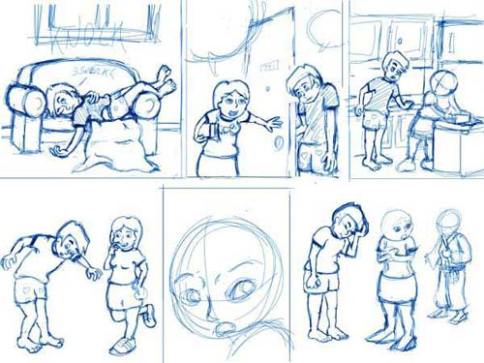
Here’s Erik’s ‘pencil rough’ for the March 13 panel of ‘Hex Libris” — except he’s done it digitally.
“They look a lot like my traditional sketches look, since I use a col-erase blue to do my roughs on paper,” he says.
“I’m most of the way done with this roughing, I have some poses to adjust, some faces to finish and I’ve got to fix the perspective on the backgrounds, which are currently just scribbled in. Oh, and I need a background in the final panel. Painter has a perspective grid, which is useful for simple 2-point perspective, so I’ll be using that to get the kitchen sorted properly.

Erik has been a student of
I’ve done so much study over the last few years as to what makes a comic a comic as opposed to an illustrated story,” Erik says. ”It’s a constant struggle between what needs to be put in the picture and what needs to be said ‘out loud’ in words.”
For inspiration, Kuntz looks to the late “father of Manga” Osamu Tezuka (”Kimba the White Lion was my favorite show as a kid,” Kuntz says. “It was cartoony without being overly simple.”
He also draws from the late E.C. Seegar, the creator of Popeye and Thimble Theatre. “I like the older style of newspaper comics, where the adventure strips had a more realistic look.”
There are a huge number of ppl doing them now.
Early days, doing tremendously.
Most of them are very poor. You won’t get it if you weren’t out drinking the night before.
There are quite a few brilliant child-friendly comics.
Some people thew business model is web advertising, especially if you’re drawn to a certain one,.
Penny-Arcade.com..
If you don’t lnpw anything about video games you’;lbe mystified by the strip,
Advertising art.
Others are off advertising on their site, or sales of merchandize, T-shirts and print versions of ytheir work, and their artisitic expression and online portfolio.
I wouldn’t think that ppl doing the webcomics,
Aren’tmakiny money,
There is a stunning amount of good work out there, on the web, and a much
Web an ideal way for me to do a serial.
Web is an inexpensive way to put the work out there and much easier way to get it in front of somebody.
With the web and the social network everyone’s sharing things, pointg it tout toe each other, it’s a new milleu, an old art form anbut a different way of delivering it.
could do it free,
I think every artist that does children’s stuff, cartoony stuff.
Kids are more ., kids are reading comics on the web.
My web brouwser, opens all the comics I want to each in tabs. I don’t read them in the newspaper.
Traditional newspaper strips,
Calving and Hobbes being run again and again on the web. They syndicate.
Kidsa nolw reading Calvin and Hobbes on the web.,
Hald of them are newspaper strips and half are web only strips.
The interesting thing about comics is it could be a way to get ppl to your site,
Comic and the dog thing, anything they want to like and put elsewhere they can put ,
Imbedded my website address into the picture,
Then they canb
Its hard for everyone to say, content is not as sacred than it used to be.
url on the left, name and copyright infor































 had just written itself, so transparency was the goal. One what that I tried to do that was by being very rigorous about capturing the rhythm of ordinary conversations, right down to the silence is something that Mark Siegel encouraged me to do. Sometimes it’s important, those pauses between speech are vitally important to capturing a credible rhythm of speech. Something that a lot of comics feel they don’t have the time to do, especially if you’ve got a 23 page story, having a panel of somebody just in between sentences, taking a sip of coffee or something, you’re not going to see that. And yet that’s something that we intuitively recognize as the music of humans in conversation. And when we recognize it, they become real. And when they become real, you stop thinking about panel transitions, you stop thinking about composition choices, you stop thinking about bleeds and you are lost in the world of the story. The first line of offense in conquering the reader’s perception of a real illusionistic world inside that story is the way people act with other people. You get that right and you’re more likely to be able to cast that spell and keep readers in the story.
had just written itself, so transparency was the goal. One what that I tried to do that was by being very rigorous about capturing the rhythm of ordinary conversations, right down to the silence is something that Mark Siegel encouraged me to do. Sometimes it’s important, those pauses between speech are vitally important to capturing a credible rhythm of speech. Something that a lot of comics feel they don’t have the time to do, especially if you’ve got a 23 page story, having a panel of somebody just in between sentences, taking a sip of coffee or something, you’re not going to see that. And yet that’s something that we intuitively recognize as the music of humans in conversation. And when we recognize it, they become real. And when they become real, you stop thinking about panel transitions, you stop thinking about composition choices, you stop thinking about bleeds and you are lost in the world of the story. The first line of offense in conquering the reader’s perception of a real illusionistic world inside that story is the way people act with other people. You get that right and you’re more likely to be able to cast that spell and keep readers in the story. versation format, so I’m going to be in conversation with somebody. But then I’ll have some visuals standing by so I can show process stuff, I can show excerpts, I can show art from the book, things like that. But otherwise, I had suggested that it be conversation format just so that each talk is different. So if you see me in New York or Chicago or LA, each one of those conversations is going to be different and that way if – for the ones that wind up on the web, they’ll all be their own unique conversation which ought to be a lot of fun. But there will still be some visuals thrown in. And I should mention, I’m still doing the full prepared visual lecture thing. That’ll also be happening and already we have about five more talks in the spring that are slipping in between the cracks, even though I’m also going to six countries. It’s kind of insane. We’re doing 14 cities in 16 days followed by England, Spain, Italy, Germany, France and the Netherlands, all of it in February, March and April. But I’ve also managed to slot in talks in Mississippi, Virginia, Ohio and Vermont into that same period and with a couple of others that are about to land as well. Those things that are a bit separate that I’ve arranged for separately, those are going to be the full stand up, hour long visual lecture which has hundreds of images going by very fast and that’s quite a show. These were organized separately, they’re not just a part of the promotional tour, though of course I’ll talk about The Sculptor a little.
versation format, so I’m going to be in conversation with somebody. But then I’ll have some visuals standing by so I can show process stuff, I can show excerpts, I can show art from the book, things like that. But otherwise, I had suggested that it be conversation format just so that each talk is different. So if you see me in New York or Chicago or LA, each one of those conversations is going to be different and that way if – for the ones that wind up on the web, they’ll all be their own unique conversation which ought to be a lot of fun. But there will still be some visuals thrown in. And I should mention, I’m still doing the full prepared visual lecture thing. That’ll also be happening and already we have about five more talks in the spring that are slipping in between the cracks, even though I’m also going to six countries. It’s kind of insane. We’re doing 14 cities in 16 days followed by England, Spain, Italy, Germany, France and the Netherlands, all of it in February, March and April. But I’ve also managed to slot in talks in Mississippi, Virginia, Ohio and Vermont into that same period and with a couple of others that are about to land as well. Those things that are a bit separate that I’ve arranged for separately, those are going to be the full stand up, hour long visual lecture which has hundreds of images going by very fast and that’s quite a show. These were organized separately, they’re not just a part of the promotional tour, though of course I’ll talk about The Sculptor a little.

























 <— You.
<— You. <— Some jerk.
<— Some jerk.
 <— Jeff
<— Jeff <— Some jerk.
<— Some jerk.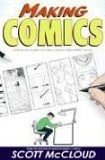





[…] The Museum of Comic & Cartoon Art has announced its MoCCA Fest 2015 line-up. The list includes a bunch of New Yorkery names, including Ben Katchor, R. Sikoryak, Francoise Mouly, Aline Kominsky-Crumb and Michael Kupperman. A panel on Saul Steinberg is one of the highlights. The Beat has the all the info. […]